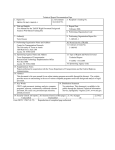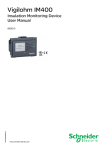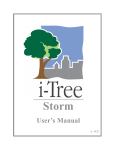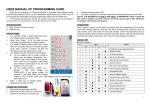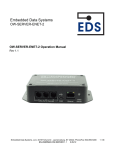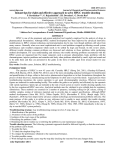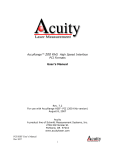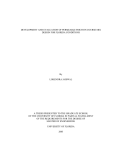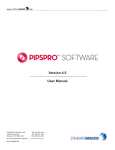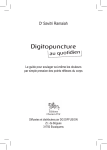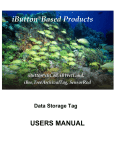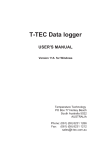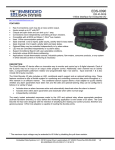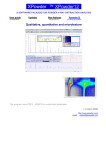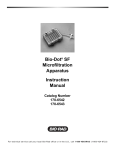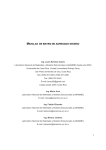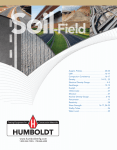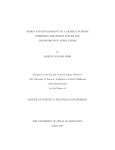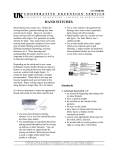Download Winter Maintenance Issues Associated With New Generation Open
Transcript
1. Report No. Technical Report Documentation Page 2. Government Accession No. 3. Recipient’s Catalog No. FHWA/TX-08/0-4834-2 4. Title and Subtitle 5. Report Date February 2007 6. Performing Organization Code Winter Maintenance Issues Associated with New Generation Open-Graded Friction Courses 7. Author(s) 8. Performing Organization Report No. Yetkin Yildirim, Terry Dossey, Ken Fults, Maghsoud 0-4834-2 Tahmoressi, and Manuel Trevino 9. Performing Organization Name and Address 10. Work Unit No. (TRAIS) Center for Transportation Research 11. Contract or Grant No. The University of Texas at Austin 0-4834 3208 Red River, Suite 200 Austin, TX 78705-2650 12. Sponsoring Agency Name and Address 13. Type of Report and Period Covered Texas Department of Transportation Technical Report Research and Technology Implementation Office Sept. 2004–Aug. 2005 P.O. Box 5080 14. Sponsoring Agency Code Austin, TX 78763-5080 15. Supplementary Notes Project conducted in cooperation with the Texas Department of Transportation and Federal Highway Administration. Project Title: Cold Weather Performance of New Generation Open-Graded Friction Courses 16. Abstract The improved ride quality and other possible safety benefits associated with New Generation Open-Graded Friction Course (NGOGFC) or Permeable Friction Course (PFC) pavements—better friction, lower noise, less splash and spray, higher visibility, reduced hydroplaning, and reduced nighttime surface glare in wet weather conditions—have made them highly attractive to engineers and contractors in the last 3 decades. Nevertheless, the durability problems and performance and maintenance issues exhibited by NGOGFCs under winter weather conditions, especially the fast formation of black ice, have prevented their widespread use. Recent research has investigated new preventive methods and materials for handling these winter maintenance issues and improving durability in NGOGFCs. In 2005, the Center for Transportation Research (CTR) conducted an online survey of different districts within the Texas Department of Transportation (TxDOT) to gather information on NGOGFCs, and in 2004–2005 CTR conducted lab and field experiments to test the methodology for detecting black ice formation on NGOGFCs. This report presents the findings of the CTR survey results and research. 17. Key Words 18. Distribution Statement Open-Graded Friction Course, permeable mixes, No restrictions. This document is available to the noise, skid, black ice, winter maintenance, wet public through the National Technical Information weather accidents. Service, Springfield, Virginia 22161. www.ntis.gov 19. Security Classif. (of report) 20. Security Classif. (of this page) 21. No. of pages Unclassified Unclassified 82 Form DOT F 1700.7 (8-72) Reproduction of completed page authorized 22. Price Winter Maintenance Issues Associated with New Generation Open-Graded Friction Courses Yetkin Yildirim Terry Dossey Kenneth W. Fults Maghsoud Tahmoressi Manuel Trevino CTR Technical Report: Report Date: Research Project: Research Project Title: Sponsoring Agency: Performing Agency: 0-4834-2 February 2007 0-4834 Cold Weather Performance of New Generation Open-Graded Friction Courses Texas Department of Transportation Center for Transportation Research at The University of Texas at Austin Project performed in cooperation with the Texas Department of Transportation and the Federal Highway Administration. Center for Transportation Research The University of Texas at Austin 3208 Red River Austin, TX 78705 www.utexas.edu/research/ctr Copyright (c) 2008 Center for Transportation Research The University of Texas at Austin All rights reserved Printed in the United States of America iv Disclaimers The contents of this report reflect the views of the authors, who are responsible for the facts and the accuracy of the data presented herein. The contents do not necessarily reflect the official views or policies of the Federal Highway Administration or the Texas Department of Transportation. This report does not constitute a standard, specification, or regulation. There was no invention or discovery conceived or first actually reduced to practice in the course of or under this contract, including any art, method, process, machine, manufacture, design or composition of matter, or any new and useful improvement thereof, or any variety of plant, which is or may be patentable under the patent laws of the United States of America or any foreign country. NOT INTENDED FOR CONSTRUCTION, BIDDING, OR PERMIT PURPOSES Dr. Yetkin Yildirim, P.E. (Texas No. 92787) Kenneth W. Fults, P.E. (Texas No. 38994) v Preface This is the second and final report from the Center for Transportation Research on Project 0-4834. This report presents the results and findings of the information collected from the test sections for the first year of a two-year project. Acknowledgments This project was initiated and has been sponsored by the Texas Department of Transportation (TxDOT). The financial support of TxDOT is greatly appreciated. The authors would like to thank TxDOT Project Director, Dr. Andrew Wimsatt, P.E., for his guidance. Special thanks are also extended to personnel in the Amarillo, Wichita Falls, and Fort Worth districts for assistance in placing pavement sensors and for everyone involved in responding to the questionnaire. Products This report contains Products P2 (questionnaire expanded to the national audience) as Appendix A, and P3 (updated in situ field temperature and humidity results) as Appendix C. Appendix D includes all items associated with Product 7 (Plans for Ice Detection Hardware; List of Materials Needed, including price and vendors; plus a User Manual). Product 7 is a standalone product (CD ROM). vi Table of Contents 1. Summary of Report 0-4834-2 ................................................................................................... 1 1.1 Winter Maintenance Practices ...............................................................................................2 1.2 Survey ....................................................................................................................................2 1.3 Field Work .............................................................................................................................3 1.4 Recommendations for Winter Maintenance of PFCs ............................................................3 2. Cold Weather Performance of NGOGFCs National Survey ............................................... 5 2.1 Introduction ............................................................................................................................5 2.2 National Survey .....................................................................................................................5 2.3 NGOGFC Use ........................................................................................................................6 2.3.1 Criteria for Use .............................................................................................................. 6 2.3.2 Advantages ..................................................................................................................... 7 2.3.3 Disadvantages ................................................................................................................ 8 2.3.4 Summary ........................................................................................................................ 9 2.4 Performance and Cost ............................................................................................................9 2.4.1 Typical Service Life ....................................................................................................... 9 2.4.2 Performance ................................................................................................................. 10 2.4.3 Relative Cost ................................................................................................................ 13 2.4.4 Summary ...................................................................................................................... 13 2.5 Maintenance .........................................................................................................................13 2.5.1 Winter Maintenance ..................................................................................................... 14 2.5.2 Black Ice ...................................................................................................................... 15 2.5.3 Comparison of De-Icing Use ....................................................................................... 16 2.5.4 Winter Maintenance Cost ............................................................................................ 16 2.5.5 Rate of Accidents ......................................................................................................... 16 2.5.6 Permeability Monitoring .............................................................................................. 16 2.6 Other Issues..........................................................................................................................17 2.6.1 Asphalt Content ........................................................................................................... 17 2.6.2 Mix Temperature ......................................................................................................... 17 2.6.3 Polymer Asphalt Binder ............................................................................................... 17 2.6.4 Additives ...................................................................................................................... 17 2.6.5 Tack Coat Material ...................................................................................................... 18 2.6.6 Specified Target Air Voids .......................................................................................... 18 2.6.7 Placement over Concrete ............................................................................................. 18 2.6.8 Summary ...................................................................................................................... 19 2.7 Comments from Selected States ..........................................................................................19 2.7.1 California ..................................................................................................................... 19 2.7.2 Florida .......................................................................................................................... 19 2.7.3 Other States .................................................................................................................. 20 3. Cold Weather Performance of PFCs Lab Report ................................................................ 21 3.1 Introduction ..........................................................................................................................21 3.2 Equipment ............................................................................................................................21 3.2.1 The British Pendulum Tester ....................................................................................... 22 vii 3.2.2 Permeameter ................................................................................................................ 22 3.2.3 Thermochrons .............................................................................................................. 23 3.2.4 Hygrochron .................................................................................................................. 24 3.3 Materials ..............................................................................................................................24 3.4 Tasks ....................................................................................................................................24 3.4.1 Permeability ................................................................................................................. 24 3.4.2 Friction Properties ........................................................................................................ 25 3.5 Results and Analysis ............................................................................................................25 3.5.1 Permeability ................................................................................................................. 25 3.5.2 Friction Properties ........................................................................................................ 26 4. In-Situ Ice Detection ............................................................................................................... 27 4.1 Field Work ...........................................................................................................................27 4.2 Concept of Latent Heat of Fusion ........................................................................................29 4.3 Selection and Instrumentation of Field Test Sections .........................................................30 4.4 Experimental Results ...........................................................................................................31 4.5 Laboratory Experiment ........................................................................................................33 4.6 Conclusions and Future implementation .............................................................................35 5. Conclusions and Recommendations ...................................................................................... 39 5.1 National Survey of Practice .................................................................................................39 5.2 Lab Results for Permeability and Abrasion Testing ............................................................40 5.3 Methodology for Remote Detection of Icing .......................................................................41 5.4 PFCs Construction and Maintenance Related to Geographic Location ..............................41 References .................................................................................................................................... 43 Appendix A: National Survey Questionnaire ........................................................................... 45 Appendix B: Comparison Charts .............................................................................................. 57 Appendix C: Test Results ........................................................................................................... 61 Appendix D: Ice Detector Plans and User Manual .................................................................. 63 viii List of Figures Figure 2.1: Criteria for using NGOGFC pavements ....................................................................... 7 Figure 2.2: Advantages of using NGOGFC pavements.................................................................. 8 Figure 2.3: Disadvantages of using NGOGFC pavements ............................................................. 9 Figure 2.4: Service life of NGOGFC pavements .......................................................................... 10 Figure 2.5: NGOGFC performance ratings .................................................................................. 11 Figure 2.6: Average ranking of the effectiveness of winter maintenance techniques .................. 15 Figure 2.7: Average ranking of the effectiveness of techniques to mitigate black ice ................. 16 Figure 3.1: British Pendulum Tester ............................................................................................. 22 Figure 3.2: Permeameter ............................................................................................................... 23 Figure 3.3: Dallas Semiconductor Thermochron .......................................................................... 23 Figure 3.4: Hygrochron................................................................................................................. 24 Figure 4.1: Dallas Semiconductor Thermochron i-Button. .......................................................... 28 Figure 4.2: Ice on CRCP, Amarillo, Texas ................................................................................... 29 Figure 4.3: Phase change temperature plateaus illustrating latent heat of fusion in water ........... 30 Figure 4.4: Snowfall event at Amarillo test section, November 29, 2004 .................................... 32 Figure 4.5: Possible evidence of black ice in NGOGFC section in Amarillo, November 29, 2004............................................................................................................................. 33 Figure 4.6: Black ice formation in one of the NGOGFC laboratory specimens........................... 34 Figure 4.7: Example of freeze-thaw cycles with black ice formation in the presence of water in one of the laboratory samples ............................................................................. 34 Figure 4.8: Temperature changes in both specimens with the application of de-icing or anti-icing chemicals .......................................................................................................... 35 Figure 4.9: Transceivers for the wireless network ........................................................................ 37 Figure 4.10: Solar panel, meter, and battery ................................................................................. 37 Figure 4.11: Yagi directional antenna with 22-mile range (line-of-sight) .................................... 37 Figure 5.1: Texas Ice and Wind Map............................................................................................ 42 Figure A.1 Question and Results on NGOGFC Use..................................................................... 53 Figure A.2 Question and Results on Advantages of NGOGFC Use ............................................ 53 Figure A.3 Question and Results on Disadvantages of NGOGFC Use ........................................ 54 Figure A.4 Question and Results on Performance Rating for NGOGFC ..................................... 54 ix Figure A.5 Question and Results on the Effectiveness of Winter Maintenance Techniques ....... 55 Figure A.6 Question and Results of the Effectiveness of Techniques to Mitigate Black Ice ....... 55 Figure B.1 Comparison of Permeability with Asphalt Rubber Binder. ........................................ 59 Figure B.2 Comparison of Permeability with PG 76-22 Binder................................................... 59 Figure B.3 British Pendulum Number Comparison with Asphalt Rubber Binder ....................... 60 Figure B.4 British Pendulum Number Comparison with PG 76-22 Binder ................................. 60 Figure D.1. Thermochron embedded in asphalt pavement ........................................................... 63 Figure D.2. Installation of embedded and ambient sensors on a test section. .............................. 63 Figure D.3. TZR and HA6 transceivers ........................................................................................ 64 Figure D.4. Control box and solar panel mounted on pole. .......................................................... 65 Figure D.5. Solar radiation zones in the United States. ................................................................ 65 Figure D.6. Diagram of a purpose built remote solar powered instrumentation box ................... 66 Figure D.7 High gain YAGI antenna showing U-bolt for pole mounting. ................................... 67 Figure D.8 Network topology for ice detection systems .............................................................. 70 x List of Tables Table 3.1: Permeability Test Comparison Test Results Asphalt Rubber and PG 76-22 Binders .............................................................................................................................. 25 Table 3.2: British Pendulum Tester Results for Asphalt Rubber and PG 76-22 Binders ............. 26 Table C.1 Permeability Test with PG 76-22 Binder ..................................................................... 61 Table C.2 British Pendulum Tester Test with PG 76-22 Binder .................................................. 61 Table C.3 Permeability Test with Asphalt Rubber Binder ........................................................... 61 Table C.4 British Pendulum Tester Test with Asphalt Rubber .................................................... 62 Table C.5 Average Values of Permeability Test with Asphalt Rubber and PG 76-22 Binders .............................................................................................................................. 62 Table C.6 British Pendulum Tester Test with Asphalt Rubber and PG 76-22 Binders ................ 62 Table D.1 Itemized Cost to Assemble One Remote Monitoring Station...................................... 67 xi xii 1. Summary of Report 0-4834-2 The open-graded structure of open-graded friction courses (OGFC) draws water off the surface of the pavement, which may lead to increased safety in wet weather conditions (1). Early OGFC mixes experienced problems with lack of durability and winter performance and maintenance issues, such as raveling within a short period of time, clogging of the open permeable pores, and fast ice and frost accumulations, all of which led to a discontinuation of the mixes. However, changes in open-graded mixture technology in the past decade have brought increased interest in the use of new generation open-graded friction courses (NGOGFCs) or Permeable Friction Courses (PFCs). Currently, many countries in Europe, including Austria, Belgium, France, Germany, Italy, the Netherlands, Spain, Switzerland, and the U.K., as well as several states in the U.S. (mostly in the western and southern regions including Arizona, Georgia, Oregon, Texas, and Utah) are using PFCs (2). PFCs are more open graded, have increased air void structures at a minimum of 18%, contain more asphalt (20% or more), and are enhanced with polymer asphalt, rubber asphalt, and fiber additives (3). Potential benefits of PFC mixes are lower noise, improved visibility in wet weather conditions, reduced splash and spray, reduced hydroplaning, reduced night-time surface glare, and improved skid resistance. The permeability of PFCs allows water to be removed from the surface of the road at a faster rate than that occurring in conventional pavements. High-speed traffic helps to clean the voids in the PFC by the pumping action produced by the vehicular tires. PFCs that are polymer-modified and contain fibers with lower moisture susceptibility can have a lower tendency to ravel in cold climates and freeze-thaw cycles. The problem with PFCs is the uncertainty regarding their performance under winter weather conditions, especially in rapid freezing conditions where some moisture may be trapped in the open mixes—conditions that might cause black ice—an extremely hazardous situation for vehicles driving at high speeds or with improper tires. Some of the North Texas areas (Dallas– Fort Worth) have reported that these mixes are “the first to freeze and the last to thaw” and are therefore problematic during rapidly advancing freeze conditions and especially during rapid freeze-thaw cycles (i.e., a nightly freeze with daily thaw). Owing to its open-graded characteristics, the surface temperature of PFCs naturally tends to be several degrees lower than dense-graded pavements because the high air void range makes the pavement less heat conductive, at about 40% to 70% less than that of a dense-graded mixture. Ice and snow accumulate faster on PFC pavements because of its more open-graded structure and thaw more slowly and refreeze more quickly. The most serious pavement performance problems caused by winter issues are tire stud rutting, gouging and scarring from snowplows, and clogging. According to a study done by H. A. Smith in 1992, European countries have much more experience with winter maintenance of PFCs. Winter maintenance activities require special procedures and an increase in de-icing chemicals both in Europe and the U.S. in general, although approaches vary greatly from place to place (4). Although numerous surveys have addressed and discussed the issue of PFC winter maintenance, no comprehensive or conclusive study or survey on the performance, construction, and design of PFCs in winter conditions has been conducted. 1 1.1 Winter Maintenance Practices First, PFCs need to have their own winter maintenance regimen with correct information on their behavior at different temperatures near or below freezing. Then procedures before and after winter storms must be established, including the provision of frequent, specialized training to drivers of snowplows and the utilization of preventive salting or de-icing chemicals. Sanding PFCs to remove ice must be eliminated to keep PFCs from clogging; it is not effective because small sand particles get into pavement’s pores, which cause clogging. New technologies can also help maintain PFCs in winter conditions and help reverse damage incurred during winter conditions. One avenue of research includes investigating new materials or salt alternatives for de-icing roads. These include prewetted salt that may stick better to the pavement surface, new ways of spreading salt solutions to reduce the chance of it being washed away, the use of alternatives to sodium chloride to reduce corrosion–such as the two deicing agents calcium magnesium acetate (CMA) and Clearway (a noncorrosive, liquid-acetate solution)–the use of de-icing agents that are more viscous and can be retained on the surface for a longer period of time, and the investigation electrostatic charge technology as a way of bonding de-icing agents to the surface. Three methods of cleaning clogged pavement are being used and researched in Europe and Asia: a fire hose, a high pressure cleaner, or a specially manufactured cleaning vehicle. 1.2 Survey In 2005, the Center for Transportation Research conducted an online survey on NGOGFC design, maintenance, performance, regional practices, performance ratings, and in particular, cold weather maintenance practices. The survey was distributed online to all TxDOT districts. Twenty-three personnel from TxDOT districts responded to the survey, of which eleven currently use NGOGFCs. Nine of the twenty-three respondents never used NGOGFCs and three used them in the past but have since discontinued their use. Respondents were asked to rank the most important benefits of NGOGFCs. According to the survey, reduced splash and spray was ranked highest; skid resistance and smoothness were ranked second-most important, followed by noise and smoothness. Each benefit, however, received an average ranking between excellent and very good. Respondents did not indicate any serious problems with NGOGFC pavements in terms of raveling in wheel paths, deformation rutting, potholes, fat spots or bleeding, stripping, reflective cracking, thermal cracking, tire stud rutting, gouging or scarring, new construction roughness (IRI), clogging, noise level inside vehicle, or icing. According to the survey, respondents ranked the most important advantage of NGOGFCs as improved wet weather skid resistance and improved road marking visibility during wet weather. Improved driver visibility on wet pavement (reduced spray) ranked in the top three. On the other hand, construction or initial cost of NGOGFCs was considered to be the biggest disadvantage by respondents. Responses indicate that NGOGFC mixes are 22.5% more expensive than dense-graded mixes. Winter maintenance was ranked as the next greatest disadvantage of the PFCs. The survey reveals that districts believe the most significant problems of NGOGFCs maintenance are related to NGOGFCs staying frozen longer and NGOGFC tearing, shoving, and pushing. Among TxDOT districts, the most common winter maintenance activity was identified as the use of sand during winter weather events in NGOGFC pavement areas; overall, anti-icing 2 agents were ranked as the most effective technique. All twelve respondents indicated that they do not use prewetted salts in their winter maintenance activities on NGOGFC pavements. In order to combat black ice, the most commonly used method is sanding, followed by advisory signs, anti-icing agents, and liquid de-icers. Respondents rated the average service life of the pavements as ranging from less than six years to ten to twelve years, with most respondents indicating a service life of ten to twelve years. In terms of design, the binder grade most often used is PG 76-22. Finally, permeability is not measured regularly but many respondents indicated that it is measured at the time of construction, generally using the NCAT procedure, the TEX-246-F method, or by applying water from a water truck to check drainage. 1.3 Field Work In the winter of 2004–05, the Center for Transportation Research conducted a project to test the methodology for detecting ice formation in NGOGFC pavements at three locations in North Texas. The project was very beneficial for learning about the reliability of the methodology and in collecting data on black ice formation. I-Buttons were installed in the field and they proved to be reliable under field conditions and traffic exposure, yielding an unprecedented set of highly detailed data. The selection of field test sections was conducted according to the following two criteria: (1) the high probability of freezing weather and precipitation and (2) the existence of permeable friction course sections. Only the region of Texas north of Dallas–Fort Worth routinely experiences freezing precipitation and the only existing NGOGFC pavements in this area are located in the Amarillo, Wichita Falls, and Fort Worth districts. The Lubbock district had some NGOGFC sections in the planning stage but none were built prior to winter 2004. 1.4 Recommendations for Winter Maintenance of PFCs In terms of materials, sand is most commonly used and is moderately effective but its small particles get lodged easily in the pavement’s pores and cause clogging. The use of dry solid chemicals can be effective only when there is sufficient moisture or accumulation on the pavement to prevent loss of material off a dry pavement and to trigger the solution of the salt. Liquid chemicals are useful in their ability to be placed uniformly over the pavement at relatively fast spreading speeds and onto dry pavement as a prestorm treatment. Liquid chemicals can be used to prevent the formation of frost or black ice. However, the chemical should be applied before the expected time of ice formation so that the water component of the chemical will evaporate or be removed by traffic action. Traffic condition is a dominant factor only between 28°F and 35°F. However, liquid chemicals are not recommended for combating freezing rain or a sleet storm. Liquid chemicals are more useful as anti-icing agents than as de-icing agents. Liquid chemicals must be applied before snow has accumulated because snow keeps the chemical from reaching the pavement and may dilute the chemical. For optimal efficiency, liquid chemicals should be used at temperatures above 23°F. However, liquids can be used at pavement temperatures lower than recommended by increasing the application rate over the levels that are recommended (5). The advantage of using de-icing agents lies in their usefulness in removing snow and ice that is already bonded to the road surface. However, their primary disadvantages are that they 3 cannot maintain the safest road conditions, they require an application of more material than do anti-icing agents, and they are reactive. Snowplows and tire studs are useful in northern climates with heavy snow and severe winter conditions but they cause gouging and scarring of pavement. Salt may be useful only when it is applied on dry surfaces before precipitation occurs and when temperatures are lower than 14°F (6). In the event of prolonged snowing, salt can be supplemented with a calcium chloride solution to remove thick ice and snow pack from spaces on the surface. The use of prewetted salts and chemicals may be effective as an anti-icing treatment. These salts may spread more uniformly, adhere better to the road surface, and work faster and longer. Anti-icing treatments, including prewetted salts and chemicals, require precise timing. 4 2. Cold Weather Performance of NGOGFCs National Survey 2.1 Introduction New generation open-graded friction course (NGOGFC) mixes have many safety and noise benefits that are of interest to transportation engineers—such as good friction, lower noise, reduced hydroplaning, high visibility, reduced splash and spray, and reduced night-time surface glare in wet weather conditions (7). However, the early open-graded friction course mixes had problems with lack of durability and winter performance and maintenance, which caused some areas to discontinue use of the mixes. Because of changes in open-graded mixture technology in the past decade, there has been increased interest in the use of NGOGFCs, or permeable friction courses (PFCs) as they are known in Texas. NGOGFC mixes are more open graded, have increased air void structures, have more asphalt, and are enhanced with polymer asphalt, rubber asphalt, and fiber additives. The design of the NGOGFC has reduced some of the durability problems associated with the first generation mixes (7). However, it is unclear whether or not advances in NGOGFC technology will solve the problems with performance in winter conditions. These open mixes may still allow accumulations of moisture through rain, snow, or sleet and during rapid freezing events “black ice” can be produced, which can be a serious concern for vehicles traveling at high speeds or with improper tire inflation or tread depth. Many regions prone to snow or ice have not considered using NGOGFCs because of their potential winter problems but some countries in Europe have established winter maintenance programs to address these potential safety concerns. These programs have also been implemented by some states in the U.S. In order to answer specific questions surrounding the actual use of NGOGFC mixes, a survey was distributed to TxDOT districts, state departments of transportation (DOTs), and international agencies to establish the patterns of NGOGFC use and issues related to performance and cost, maintenance, and material properties. Results of this survey will be used in coordination with results from a study of NGOGFC in the field. The discussion that follows will review the results of the survey. 2.2 National Survey An online survey of the use, mix design, construction, and general and winter performance and maintenance was distributed to TxDOT districts, state DOTs, and international agencies. The objective of the survey was to gather information on NGOGFC design, maintenance, performance issues, and current practice by region. Information related to the cold weather performance of NGOGFCs and associated practices was also collected. Twenty-six responded to the survey. These responses were compiled and analyzed to obtain specific information about NGOGFC mixes. The results are presented according to specific questions asked in the survey. The survey was specifically for NGOGFCs only, stating that “NGOGFCs have at least 18% air voids and many contain polymer modifiers and/or asphalt rubber.” The survey was not intended to address old plant mix seals or old generation OGFCs. The survey did note, however, 5 that in Texas NGOGFC pavements are often referred to as PFC (permeable friction course) pavements; therefore, these pavements were also included in the survey. The survey was organized according to NGOGFC use, performance and cost, maintenance, other issues relating to NGOGFC material properties, and a final section for respondents’ comments. The survey included a total of 57 questions and was distributed as both PDF and Excel files. 2.3 NGOGFC Use Out of 26 respondents to the survey, 11 (42%) use NGOGFCs, 5 (19%) never used NGOGFCs, and 10 (38%) have discontinued its use. Of those who have used but no longer use NGOGFCs, 64% cite performance as the reason for discontinuation, 45% cite maintenance problems, and 36% cite other reasons. Zero percent report cost as the reason for discontinuing use of NGOGFCs. Six (26%) respondents reported that they use NGOGFCs on roads with speed limits less than or equal to 45 mph. Fourteen (61%) respondents use NGOGFCs on roads with speed limits over 45 mph. Seven (32%) respondents reported that they have used NGOGFCs in curb and gutter sections; and 15 (68%) reported that they have not. 2.3.1 Criteria for Use The questionnaire listed eight issues that agencies may use to determine whether or not to use NGOGFC mixes in their area, with the option of listing other criteria used in their decisionmaking process. These eight criteria included the following: • Traffic level • Environment (freezing or not; wet or dry) • Skid resistance • Noise • Reduced splash and spray • Smoothness • Cost • Durability Respondents were asked to rank the criteria from 1 to 9, with 1 being the most important criteria. A copy of the question and results is presented in Appendix A as Figure A.1. When analyzing the results, criteria that were given the rankings 1 through 4 were considered to be the most important factors in making decisions about NGOGFC use. The number of respondents per criteria ranked 1 through 4 was calculated. Figure 2.1 shows the results from this question. Skid resistance was ranked the highest in importance by the most respondents, a total of 11. Noise and reduced splash and spray were the next most important, with 10 respondents each citing them as the most important criteria. Finally, in order of importance, were traffic level (6), durability (5), smoothness (4), environment (3), cost (3), and other criteria (1). 6 Number of Respondents 12 Traffic Level 10 Environment 8 Skid Resistance Noise 6 Splash & Spray Smoothness 4 Cost 2 Durability 0 Criteria Figure 2.1: Criteria for using NGOGFC pavements 2.3.2 Advantages The questionnaire asked respondents to identify the main advantages and disadvantages with the use of NGOGFC. Six possible advantages were offered to respondents, with the option of identifying other advantages and disadvantages not listed. A copy of the question and results is located in Appendix A as Figure A.2. The possible advantages included the following: • Improved driver visibility on wet pavement (reduced spray) • Improved wet weather skid resistance • Improved road marking visibility during wet weather • Noise • Cost • Durability Respondents were asked to rank the advantages from 1 to 7, with 1 being the greatest advantage. When analyzing the results, criteria that were given the rankings 1 through 3 were considered to be the most important advantages to using NGOGFCs. The number of respondents per category ranked 1 through 3 was calculated. Figure 2.2 shows the results from this question. Improved driver visibility on wet pavement (reduced spray) and improved wet weather skid resistance were deemed the most advantageous by respondents, with 11 respondents in each category ranking them in the top 3. Improved road marking visibility during wet weather followed with 6 respondents ranking it in the top 3. Noise reduction (5), durability (3) and cost (0) were ranked low as advantages. No additional advantages were identified by the respondents. 7 Number of Respondents 12 10 Reduced Spray 8 Skid Resistance Road Visibility 6 Noise Durability Cost (N/A) 4 2 0 Criteria Figure 2.2: Advantages of using NGOGFC pavements 2.3.3 Disadvantages Five possible disadvantages were offered to respondents, with the option of identifying other advantages and disadvantages not listed. A copy of the question and results is presented in Appendix A as Figure A.3. Possible disadvantages included the following: • Initial or Construction Cost • Winter Maintenance Problems • Durability • Performance • General Maintenance Respondents were once again asked to rank the advantages from 1 to 6, with 1 being the biggest disadvantage. When analyzing the results, criteria that were given the rankings 1 through 3 were considered to be the biggest disadvantages to using NGOGFC. The number of respondents per category ranked 1 through 3 was calculated. Figure 2.3 shows the results from this question. Winter maintenance problems were considered to be the biggest disadvantage, with 9 respondents ranking this category in the top three. Initial or construction cost followed with 8 respondents ranking it in the top three. Durability, performance, and general maintenance were tied, with 6 respondents each. No additional disadvantages were identified. 8 Number of Respondents 10 9 8 7 6 5 4 3 2 1 0 Initial Cost Winter Maintenance Durability Performance 10 - 12 Years Criteria Figure 2.3: Disadvantages of using NGOGFC pavements 2.3.4 Summary Eighty-two percent of the 26 respondents stated that they had used NGOGFCs at some point. Approximately half of the 38% who had discontinued use cited performance and maintenance issues as the primary reason. Cost was not a significant factor in respondents’ decisions to discontinue use of NGOGFCs. Overall, respondents cited high wet weather skid and spray performance as the main advantage with using NGOGFCs, whereas winter maintenance, initial cost, and durability were reported as the greatest disadvantages of NGOGFC use. The respondent states that use NGOGFCs are Arizona, California, Florida, Georgia, Kansas, Nebraska, Nevada, New Jersey, North Carolina, Tennessee, and Texas. The respondent states that have discontinued use are Connecticut, Ohio, Indiana, Pennsylvania, Montana, New York, South Carolina, Vermont, and Washington; respondent cities that have discontinued use are Eureka, Oakland, and Sacramento, California. The respondent states that do not use NGOGFCs are Alaska, Kentucky, New Hampshire, New Mexico, Maine, and South Dakota. 2.4 Performance and Cost 2.4.1 Typical Service Life Nineteen respondents reported on the estimated average typical service life of NGOGFC in their respective areas. Five (26%) reported that NGOGFCs lasted less than 6 years. Another five (26%) reported that NGOGFC lasted between 6 and 8 years. Four (21%) reported that NGOGFCs lasted between 8 and 10 years. Three respondents (16%) said it lasted 10 to12 years, and only two (11%) said it lasted more than 12 years. Figure 2.4 summarizes the responses to the service life of NGOGFCs. 9 Number of Respondents 6 5 < 6 Years 4 6 - 8 Years 3 8 - 10 Years 2 10 - 12 Years > 12 Years 1 0 Number of Service Years Figure 2.4: Service life of NGOGFC pavements 2.4.2 Performance Performance Rating Performance was rated in terms of five indices, including: • Durability (e.g., stripping, raveling) • Surface friction • Splash and spray • Noise • Smoothness These indices were ranked on a 5-point scale from 5 (excellent) to 1 (poor). A copy of this question and the results are located in the Appendix A as Figure A.4. When analyzing the results, indices that were ranked excellent or very good were considered to be the highest performance ratings for NGOGFC. Indices ranked as fair or poor were considered to be low performance ratings. The number of respondents per index ranked as excellent or very good was calculated. Figure 2.5 shows the results from this question. NGOGFC splash and spray performance received the overall best rating, with fourteen respondents reporting it as excellent or very good. Thirteen respondents listed NGOGFC surface friction as excellent or very good, thus nearly tying with splash and spray and receiving the next highest performance rating. Ten respondents rated both noise level and smoothness as excellent or very good. Finally, NGOGFC durability performance received the lowest ranking, with only seven respondents rating it as excellent or very good and eight respondents rating it as fair or poor. 10 Number of Respondents 16 14 12 Durability 10 Surface Friction 8 Splash & Spray 6 Noise Smoothness 4 2 0 Criteria Figure 2.5: NGOGFC performance ratings Tire Stud Rutting Seventeen respondents reported on the frequency of occurrence of tire stud rutting with NGOGFCs. Eleven (65%) respondents reported no occurrence, three (18%) respondents cited low occurrence, two (12%) cited high occurrence, and one (6%) cited medium-level occurrence. Icing Frequency Fifteen respondents reported on the frequency of icing with NGOGFCs. Five respondents (33%) reported over 10 days of icing with NGOGFCs per year. Three (20%) experienced 5 to 10 days of icing per year and another three (20%) experienced less than 5 days of icing. Twentyseven percent stated that they never experienced icing with NGOGFCs. Raveling in Wheel Paths A total of seventeen respondents reported on the percentage area of raveling in wheel paths with NGOGFCs. Ten (59%) respondents reported less than 5% area of raveling. Five (29%) reported over 25% area of raveling and two (12%) respondents reported 5% to 25% area of raveling with NGOGFCs. Gouging or Scarring Fifteen respondents reported on the percentage level of gouging or scarring from snowplows and other machinery with NGOGFCs. Eight (53%) reported less than 5% area of gouging or scarring. Four (27%) reported an area of 5% to 25%, and three (20%) reported an area of greater than 25%. Deformation Rutting A total of sixteen respondents reported on the average depth of deformation rutting with NGOGFCs. The average depth of deformation rutting was calculated on a scale from none to high. An average depth of 0.25 in. or less was considered to have an average depth of “none,” 0.25-0.5 in. was considered to be of low average depth, 0.5-0.75 in. was considered as medium 11 average, and greater than 0.75 in. was considered high. Twelve (75%), the clear majority, reported an average depth of none. Three (19%) respondents reported a low average depth, one (6%) reported a medium average depth, and zero reported a high average depth of deformation rutting. Clogging Seventeen respondents reported on the incidence of clogging with NGOGFCs, based on splash and spray. Only one (6%) respondent reported zero clogging with NGOGFCs. Six (35%) respondents reported low levels of clogging. Another six (35%) reported medium levels and two (12%) respondents reported high levels of clogging with NGOGFCs. Two (12%) respondents stated that they did not know the level of clogging in their areas. Potholes A total of sixteen respondents reported on the number of potholes occurring with NGOGFCs in their respective areas. Five (31%) reported no potholes; ten (63%) respondents reported a low level of potholes (fewer than three potholes per mile). No respondents reported a medium level of potholes (three to five per mile) and one (6%) respondent reported a high level of potholes (more than five per mile). Fat Spots or Bleeding Sixteen respondents reported on the incidence of fat spots or bleeding with NGOGFCs. Three (19%) reported no fat spots or bleeding. Twelve reported low levels (fewer than three per mile). Zero respondents reported a medium level (three to five per mile) of fat spots or bleeding and one (6%) respondent reported a high level (more than five per mile). Noise Level inside Vehicle Out of fifteen respondents, twelve (80%) reported low noise level inside the vehicle with roads paved with NGOGFCs. Two (13%) respondents reported a medium noise level and one (7%) respondent reported a high noise level. Stripping Seventeen respondents reported on the percentage area of stripping with roads paved with NGOGFCs. Nine (53%) reported a smaller than 5% area of stripping. Two (12%) reported a 5% to 25% area and one (6%) respondent reported an area of stripping of more than 25% with NGOGFCs. Five (29%) respondents stated that they did not know the percentage of stripping with NGOGFCs for their respective areas. New Construction Roughness (IRI) Thirteen respondents reported on the new construction roughness (IRI) with NGOGFCs. Four (31%) reported a very smooth surface (less than 40 IRI). Six (46%) reported a smooth surface (40-60 IRI) and three (23%) respondents reported an average surface smoothness (60-80 IRI). Zero respondents reported a rough surface (over 80 IRI). 12 Reflective Cracking Out of fifteen respondents, seven (47%) reported that NGOGFCs in their areas experienced reflective cracking. Eight (53%) respondents reported no reflective cracking with NGOGFCs in their respective areas. Thermal Cracking Out of fifteen respondents, four (27%) reported that they experienced thermal cracking with NGOGFCs in their respective areas. Eleven (73%) respondents reported that they did not experience thermal cracking with NGOGFCs. 2.4.3 Relative Cost Fifteen respondents reported on the relative cost of NGOGFCs in place in their respective areas as compared with the equivalent depth of a typical ACP surface mix. Three respondents (20%) reported that the relative cost of NGOGFC was more than 30% more expensive. One respondent (7%) stated that the relative cost was 25% to 30% more expensive. Five (33%) reported the relative cost to be 20% to 25% more expensive. Three (20%) respondents reported the relative cost to be 15% to 20% more expensive. Two (13%) st ated it was 15% higher and one (7%) respondent said the relative cost of NGOGFC was the same. Zero respondents reported the relative cost to be less. 2.4.4 Summary The survey respondents represented a good distribution from both icing and non-icing states. Fifty-two percent of respondents reported an NGOGFC life span of 8 years or less and 73% reported a life span of 10 years or less. States reporting the longest life span for NGOGFC were Florida, Rhode Island, Nevada, Georgia, and New Jersey, with Florida and Rhode Island experiencing a life span of more than 12 years. Most states are concerned with issues related to clogging, and according to respondents, the average relative cost of NGOGFC is 25% higher than an equivalent depth of a typical asphalt concrete pavement. 2.5 Maintenance Respondents ranked the seven biggest maintenance challenges experienced with NGOGFC pavements with the option of indicating other maintenance issues not listed. The seven possible challenges presented in the survey are the following: • Pushing, shoving, and tearing • Slippage cracks • Stripping difficulties • Fuel or oil spills • Snowplow damage (gouging and scarring) • Length of frozen state • Formation of black ice 13 Among the seven possible problems, three (20%) respondents listed the formation of black ice as the number one most significant problem. Two (13%) respondents reported the most significant problem to be NGOGFCs staying frozen longer. One (6%) respondent reported snowplow damage (gouging and scarring) as the most significant problem with NGOGFCs and two (20%) respondents listed other problems. Zero respondents ranked pushing, shoving, and tearing; slippage cracks; stripping; and fuel or oil spills as the most significant problem with NGOGFCs. Fifteen (88%) of seventeen respondents indicated that special activities were used on NGOGFC pavements, with one (6%) respondent reporting that his area conducted cleaning to restore permeability. One (6%) respondent reported other activities. Fourteen (82%) of the seventeen respondents reported that special activities were used to maintain the surface condition of NGOGFC and two (12%) respondents reported that they use fog seal to maintain the surface condition. One (6%) respondent reported other special activities. 2.5.1 Winter Maintenance Winter maintenance techniques were evaluated by respondents; they were asked to rank five techniques that they currently use from 1 (ineffective) to 4 (very effective). A copy of this question and the results are located in Appendix A as Figure A.5. The techniques presented in the survey were: • Sanding • Liquid de-icing agent • Anti-icing agent • Prewetted salts • Advisory signs Respondents could answer if each of these was very effective, effective, moderately effective, or ineffective. They were also given the option to answer that they did not use a certain method at all. The average rankings that respondents gave each technique are represented in Figure 2.6. Overall, liquid de-icing agents were ranked as the most effective technique with an average rating of 3.27 (between very good and excellent). Following were anti-icing agents with an average rating of 3.13 and prewetted salts, which ranked a close third with an average rating of 3.10. Sanding as a winter maintenance technique averaged at 3.00 and advisory signs ranked lowest with an average rating of 2.33. 14 3.5 Average Ranking 3 2.5 Sanding Liquid De-Icing Agent 2 Anti-Icing Agent 1.5 Prewetted Salts 1 Advisory Signs 0.5 0 Winter Maintenance Technique Figure 2.6: Average ranking of the effectiveness of winter maintenance techniques 2.5.2 Black Ice Participants were questioned on the effectiveness of different methods for the mitigation of black ice on NGOGFC. A copy of this question and the results are located in Appendix A as Figure A.6. Participants were asked to rate the effectiveness of the following precautions against black ice: • Sanding • Liquid de-icing agent • Anti-icing agent • Prewetted salt • Advisory signs Respondents could answer if each of these was very effective, effective, moderately effective, or ineffective. They were also given the option of answering that they did not use a certain method at all. The average rankings that respondents gave each technique are represented in Figure 2.7. Overall, anti-icing agents ranked as the most effective technique in mitigating black ice, with an average rating of 3.43 (between very good and excellent). Sanding followed with an average rating of 3.40. Prewetted salts received an average rating of 3.13 and liquid deicing agents averaged at 2.86. Advisory signs again ranked lowest as an effective technique for mitigating black ice, with an average rating of 1.75. 15 4 Average Ranking 3.5 3 Sanding 2.5 Liquid De-Icing Agent 2 Anti-Icing Agent 1.5 Prewetted Salt Advisory Signs 1 0.5 0 Maintenance Technique Figure 2.7: Average ranking of the effectiveness of techniques to mitigate black ice 2.5.3 Comparison of De-Icing Use Thirteen respondents reported on how much additional de-icing chemical was used in their respective areas for NGOGFCs as compared with other pavements. Seven (54%) reported that the usage was the same. Four (31%) reported that they use 25% more de-icing chemical agent with NGOGFCs than with other pavements. One (8%) respondent stated that his area uses 50% more. Zero respondents reported using 75% more de-icing chemical agent with NGOGFCs. 2.5.4 Winter Maintenance Cost Out of eleven respondents, four (36%) reported that they spend the same amount of money on winter maintenance techniques such as prewetted salts, de-icing agents, and other items with NGOGFCs that they would with other pavements. Three (27%) respondents reported that they spend 25% more. One (9%) reported spending 25% to 50% more. One respondent (9%) reported spending 50% to 75% more and one (9%) reported spending 75% to 100% more with NGOGFCs. Only one (9%) respondent reported spending less money on winter maintenance techniques with NGOGFCs than with other pavements. 2.5.5 Rate of Accidents Participants were asked if they observed an increase in the rate of accidents on NGOGFC pavements. Of seventeen respondents to the question, zero responded yes and nine, or 53%, responded no. Six, or 35%, responded that they did not know if NGOGFC pavement caused an increase in the rate of accidents or not and two respondents, or 12%, reported other causes for an observable increased rate in accidents on NGOGFC pavements. 2.5.6 Permeability Monitoring Of twenty-one respondents, seventeen (81%) reported that they do not conduct periodic monitoring for NGOGFC permeability. Four (19%) respondents reported that they do not know 16 if their state conducts periodic monitoring and zero respondents reported that they do conduct periodic monitoring of permeability. When asked about how often permeability was measured, two (22%) out of nine respondents reported that they measured permeability when NGOGFCs were constructed. Zero respondents reported measuring permeability every 6 months or annually. Seven (78%) reported other time frequencies for measuring permeability. When asked how permeability was measured, one (25%) out of four respondents reported using the NCAT procedure. The remaining three (75%) respondents reported using other methods. 2.6 Other Issues 2.6.1 Asphalt Content Participants were asked if the range of asphalt content was specified. Out of a total of sixteen respondents, eleven (69%) answered yes and five (31%) answered no. Thirteen respondents specified a percentage rate of the asphalt content in NGOGFC. Eight (62%) reported an asphalt content of 5% to 7%. Three (23%) reported an asphalt content of 7% to 8%. One (8%) respondent reported a content of 9% to 10%. Zero respondents reported a content of 11% to 12% and one (8%) respondent reported that they did not know the asphalt content percentage rate. 2.6.2 Mix Temperature Fifteen respondents reported on establishing a mix temperature range for the prevention of asphalt draindown. Ten (67%) reported a mix temperature range above 230°F. One (7%) respondent reported a range of 215 to 230°F and one (7%) reported a range of 200° F to 15° F. Zero respondents reported using a range between 190 and 200°F and three (20%) reported not knowing. 2.6.3 Polymer Asphalt Binder Of seventeen respondents, a majority of fifteen (88%) used polymer asphalt binder in NGOGFC. Only two (12%) did not use polymer asphalt binder. 2.6.4 Additives Respondents were asked to check all the additives used that apply. Six (38%) respondents reported that they use cellulose as an additive with NGOGFC. Four (25%) use rubber as an additive, two (13%) use rock fibers, two (31%) use other kinds of additives, and another two (13%) do not use any additives at all. Performance with Rubber Twelve respondents reported on the performance of NGOGFC with rubber as compared to NGOGFC without rubber. Three (25%) reported that NGOGFC with rubber performed better and one (8%) respondent reported that the performance between the two was the same. Zero respondents reported that NGOGFC with rubber performs worse than with rubber and eight (67%) reported that the question was not applicable. Respondents then checked the indices in which rubber has the most impact if it affects performance. Four (100%) respondents reported that rubber impacts durability the most, with 17 regard to stripping and raveling. One (25%) respondent cited noise as the index to which rubber has the most impact, one (25%) cited smoothness, and one (25%) cited other indices. Zero respondents cited surface friction or splash and spray. Performance with Fiber Ten respondents reported on the performance of NGOGFC with fiber as compared to NGOGFC without fiber. Four (40%) reported that NGOGFC with fiber performed better. Zero respondents reported that NGOGFCs with fiber performed the same as those without fiber and zero reported that NGOGFC with fiber was worse. Four (40%) respondents reported that the question was not applicable and two (20%) respondents cited other answers. Respondents then checked the indices in which fiber has the most impact if it affects performance. Six (75%) respondents reported that rubber impacts durability the most, with regard to stripping and raveling. One (25%) respondent cited other indices. Two (25%) reported that they don’t know and zero respondents cited surface friction, splash and spray, noise, or smoothness. 2.6.5 Tack Coat Material Fifteen respondents (88%) reported using emulsion as a tack coat material with NGOGFCs and seven (41%) reported using asphalt cement as a material. Zero respondents reported not using any tack coat material at all. Out of 15 respondents, two (13%) respondents reported a specified application rate of tack coat of less than 0.05 gallon per square yard. Twelve (80%) reported using a specified application rate between 0.05 and 0.07 gallon per square yard. One (7%) respondent uses an application rate of over 0.07 gallon per /square yard. 2.6.6 Specified Target Air Voids Out of fourteen respondents, three (21%) specify less than 15% air voids with NGOGFC. Four (29%) specify between 15% and 18% air voids, another four (29%) specify 18% to 20% air voids, and one (7%) specifies more than 20% air voids. Fourteen percent specify other percentage levels of air voids with NGOGFC. 2.6.7 Placement over Concrete Out of seventeen respondents, fifteen (88%) respondents reported that they did not place NGOGFCs over newly constructed concrete pavement. Two (12%) reported that they did place NGOGFC over newly constructed concrete pavement. However, out of twenty-one respondents, sixteen (76%) reported not placing NGOGFC over existing concrete pavement, while five (24%) respondents reported that they did. Respondents were asked to specify what pretreatment was used when placing NGOGFC over existing concrete pavement. Four (67%) reported using tack coat, two (33%) reported grinding, one (17%) reported milling, and zero respondents reported using a seal coat or a rubberized seal coat. Four (67%) respondents reported using other forms of pretreatment; zero respondents reported not using any pretreatment. 18 2.6.8 Summary According to responses, permeability in NGOGFC is essentially never measured, let alone monitored. Twenty-one percent of respondents specify air voids less than 15%, contrary to the definition of NGOGFC. Twenty-one percent of respondents add rubber as an additive to NGOGFC and three-fourths of this 21% of the respondents say this additive is better than other additives. However, 31% of respondents reported that they use cellulose as an additive and all 31% say it is better. 2.7 Comments from Selected States 2.7.1 California • Caltrans OGAC Guidelines do not recommend using OGAC over unsound pavements, snowy or icy areas, areas with severe turning movements, curb and gutter (dry steering can cause the OGAC to ravel, yet some of our 12 districts place it along curb and gutter with mixed results), fuel or oil spill areas, mill and fill areas, and muddy and sandy areas. • Caltrans considers OGAC beneficial to reduce wet weather accidents, improve skid resistance, improve wet and nighttime visibility, and reduce road noise. • Caltrans uses AR4000 binder, PBA-6, and asphalt rubber in OGAC. • Field mixing temperatures are less than 275°F for AR4000 and less than 325°F for modified binders. • Tack coat rates are residual and vary from 0.01 to 0.07 gal. /sq. yd., depending on the type of surface to be tack coated. • For OGAC mix design, Caltrans follows California Test 368, which is available on the Internet. • Conventional OGAC is the least expensive at $48-$56/ton. Polymer-modified OGAC costs $62-$77/ton. Rubber asphalt OGAC costs $70-$83/ton. • Headquarters at Caltrans recommends removing old OGAC before overlaying it with more OGAC or DGAC. However, some of the twelve districts are overlaying OGAC without any problem. 2.7.2 Florida • Florida NGOGFC is basically a one-sieve size larger aggregate, paralleling Georgia work. • Fibers are used to prevent draindown. • Either an asphalt rubber binder or polymer-modified binder is used to increase the total binder and reduce the potential for raveling and cracking. • Florida is also looking at porous European FCs with thicker lift for improved reduction in hydroplaning potential, which is our main reason for using OGFCs in the first place. 19 2.7.3 Other States • Georgia uses OGFC primarily over SMA on interstates and for drainage where speeds exceed 45 mph. • Kansas is just beginning to use PFC, based on the Oklahoma and Texas experience. • Kentucky has only one section of OGFC on a trial basis. • Montana passed a moratorium in the 1990s against using OGFC because of stripping problems. • Nevada uses OGFC with a lower void content on almost all pavements. • Rhode Island uses dense (8% void content) FC. • Vermont has only three projects less than 2 years old. 20 3. Cold Weather Performance of PFCs Lab Report 3.1 Introduction Although the more open air void range may allow water to drain more quickly, it is unclear whether or not advances in PFCs will solve the problems with performance in winter conditions. These open mixes may still allow accumulations of moisture through rain, snow, or sleet; during rapid freezing events, “black ice” can be produced, which can be a very dangerous condition for vehicles traveling at imprudent speeds or with improper tire inflation or tread depth. The field portion of this study have showed that these mixes are “the first to freeze and the last to thaw” and are therefore problematic during rapidly advancing freeze conditions and especially during rapid freeze and thaw cycles. In both Europe and the U.S., it has been documented that the accumulation of snow, formation of ice, and action of salt and de-icing chemicals are different on PFC surfaces from on dense-graded surfaces. Because of its open-graded characteristics, the surface temperature of PFCs tends to be naturally several degrees lower than dense-graded pavements because the high air void range makes the pavement less heat conductive, at about 40% to 70% than that of a dense-graded mixture. Ice and snow accumulate faster on PFC pavements and thaw more slowly. To evaluate the cold weather performance of PFCs, samples were prepared from the most commonly used PFC mix designs from the northern part of Texas. These specimens were saturated at different levels and these saturated specimens were frozen in a deep freezer to simulate black ice formation as it occurs in the field. Thermochrons and Hygrochrons were inserted into the specimens to allow for precise logging of temperature and humidity at various depths. The onset, depth, and duration of black ice formation were recorded for each specimen. Permeability of the specimens prepared for this study was measured and their relation to the duration of black ice formation was evaluated. Additionally, friction properties of the specimens before and after black ice formation were evaluated. The surface reflectivity of the specimens was determined at this time, according to the procedure that is set in this experiment. In addition, the effect of the most important factors on winter performance was evaluated in terms of effect on permeability and friction. The most common winter maintenance techniques used include the application of salt, sand, and de-icing chemicals to the pavement with black ice. The first factor to be evaluated is the effectiveness of the various types of winter maintenance techniques on permeability and friction. The second factor was what effect repeated applications of winter maintenance techniques had on the permeability and friction of PFCs. 3.2 Equipment • British Pendulum Tester • Permeameter • Thermochrons • Hygrochrons 21 3.2.1 The British Pendulum Tester The British Pendulum Tester (8) is one of the simplest and cheapest instruments used in the measurement of friction characteristics of pavement surface. It is extremely versatile in its applications to many test situations and has received acceptance worldwide. The test device measures low-speed friction (about 10 km/h) and is commonly used to assess the microtexture of pavement surface. The values measured, BPN = British Pendulum (Tester) Number for flat surfaces and polish values for accelerated polishing-wheel specimens, represent the frictional properties obtained with the apparatus and the procedures stated herein and do not necessarily agree or correlate with other slipperiness-measuring equipment. Figure 3.1 shows a British Pendulum Tester. Figure 3.1: British Pendulum Tester 3.2.2 Permeameter The Permeameter measures the permeability of porous asphalt road mixes under laboratory conditions. This apparatus works on the falling head principle, from which the falling head with time through a porous specimen is measured with a precise pressure transducer at very close time intervals (10 readings/s). Using the falling head data, the specific discharge through the specimen can be computed and the permeability of the material obtained from the velocity versus hydraulic gradient relationship (9). Figure 3.2 depicts an image of the Permeameter. 22 Figure 3.2: Permeameter 3.2.3 Thermochrons Thermochrons, or “i-Buttons,” are the size of a thick dime and contain a temperature sensor, a battery, a network interface, and computer memory. With a waterproof coating of epoxy or latex, they can be reliably embedded in asphalt or concrete pavement and log precise temperature data effectively for a period of up to 10 years, taking a reading every 30 minutes for 6 months at a time. The data are then uploaded through a simple twisted wire pair to a palm or laptop computer. Figure 3.3 shows the relative size of the Dallas Semiconductor Thermochron. Figure 3.3: Dallas Semiconductor Thermochron 23 3.2.4 Hygrochron Hygrochrons are similar to Thermochrons but with an added humidity sensor and moisture permeable membrane. They can measure temperature with about a 0.06°F resolution, along with relative humidity. Hygrochrons are self-powered and logging like Thermochrons, so no computer or external microcontroller is required for operation (10). Figure 3.4 shows a picture of the Hygrochron. Figure 3.4: Hygrochron 3.3 Materials This laboratory experiment consists of two tests: British Pendulum Tester (BPT) and Permeability Tests. These two tests methods test two types of binders, which are Asphalt Rubber and PG 76-22, with three different types of chemicals, namely Matador (liquid, anti-icing agent), Freeze Guard (liquid, anti-icing agent), and Meltdown 20 (solid, de-icing agent). 3.4 Tasks 3.4.1 Permeability Permeable friction courses (PFC), which include new generation open-graded friction courses, asphalt-rubber friction courses, and porous European mixes (PEM), have gained wide acceptance throughout the southern and western portions of the United States. PFC mixtures are rapidly gaining popularity because of their ability to reduce hydroplaning, splash and spray, and pavement noise, and to improve ride quality and the visibility of pavement markings in wet weather (11). No widespread performance problems such as raveling have been reported with PFC but concerns remain whether PFC mixes will experience the same performance problems that plagued the first generation OGFC mixes used in freeze-thaw environments. In these environments, the benefits of PFC have generally been perceived to be outweighed by the associated inconveniences and increased cost of winter maintenance and the possible related formation of glaze (“black ice”) (11). 24 Permeability of the specimens in this laboratory experiment was measured after preparation of the specimens and after application of winter maintenance methods. This results in the provision of information on the effect of different winter maintenance techniques on permeability. 3.4.2 Friction Properties Friction properties of these specimens were measured using the BPT before and after black ice formation. After that, a series of remedial or maintenance strategies such as salt application and de-icing chemical application were applied to these specimens. These maintenance applications were repeated several times and then friction properties were measured after each cycle of application of maintenance strategies by using the BPT. 3.5 Results and Analysis 3.5.1 Permeability First, the permeability of the all specimens used in this project was measured. The permeability data from these specimens are included in Table 3.1. Then the specimens were saturated and frozen. Later three different maintenance methods were applied to the specimens. Afterwards, the permeability of the specimens was measured again. This data is also presented in Table 3.1. Table 3.1: Permeability Test Comparison Test Results Asphalt Rubber and PG 76-22 Binders Permeability Asphalt Rubber PG 76-22 Asphalt Rubber PG 76-22 Asphalt Rubber PG 76-22 Before Before After After Matador 0.635 0.7 0.595 0.5875 -6 -16 Freeze Guard 0.5675 0.75 0.61 0.635 7 -15 Meltdown 20 0.5525 0.675 0.6125 0.6575 11 -3 Change, [%] Change, [%] As can be seen from the data, all the specimens prepared with PG 76-22 binder showed a decrease in permeability. Specimens treated with Matador, a liquid anti-icing agent, and Freeze Guard, another liquid anti-icing agent, showed 15% and 16% decreases in permeability, respectively. The specimens treated with Meltdown 20, a solid de-icing agent, showed only a 3% decrease in permeability. Specimens prepared with asphalt rubber binder showed varying results. The permeability of the specimens treated with Matador decreased by 6%. On the other hand, specimens treated with Freeze Guard, a liquid anti-icing agent, and Meltdown 20, a solid de-icing agent, resulted in a 7% and 11% increase in permeability, respectively. 25 3.5.2 Friction Properties The friction properties of the specimens before and after black ice formation and the application of winter maintenance treatments are included in Table 3.2. In all cases, application of winter maintenance treatments was not enough to bring the friction properties to their initial level and a decrease in friction was observed in all cases. Table 3.2: British Pendulum Tester Results for Asphalt Rubber and PG 76-22 Binders BPN Asphalt Rubber PG 76-22 Before Before Asphalt Rubber PG 76-22 After After Asphalt Rubber PG 76-22 Change, [%] Change, [%] Matador 42 48.5 36 40 -14 -18 Freeze Guard 39 47.5 25 41 -37 -14 Meltdown 20 42 51.5 38.5 -2 -25 41 The smallest friction reduction observed was 2% with those specimens prepared with asphalt rubber and treated with Meltdown 20, a solid de-icing agent. Specimens prepared with asphalt rubber and treated with Freeze Guard, a liquid anti-icing agent, showed the highest reduction in friction properties. For those specimens prepared with the PG 76-22 binder, the highest reduction in friction properties was observed for specimens treated by Meltdown 20, the solid de-icing agent. The specimens treated with the liquid anti-icing agents Matador and Freeze Guard showed 18% and 14% decreases in friction properties, respectively. 26 4. In-Situ Ice Detection Currently, it is unclear whether advances in NGOGFC technology will solve the problems with performance under winter conditions. These open mixes might still allow accumulations of moisture through rain, snow, or sleet and during rapid freezing events “black ice” can be produced, which can be a serious concern for vehicles traveling at high speeds or with improper tire inflation or tread depth. Many regions prone to snow or ice have not considered using NGOGFCs because of their potential winter problems, but some countries in Europe have established winter maintenance programs to address these potential safety concerns. These programs have also been implemented by some states in the U.S. Transportation agencies in areas subject to freezing temperatures and black ice formation have to implement winter maintenance techniques such as de-icing and anti-icing agents, sanding and advisory signs to prevent the formation of black ice in the pavement, to reduce its duration, and in general, to minimize the incidence of accidents under adverse weather conditions. Resources for these measures have to be allocated properly, meaning that those areas and pavements with a greater probability of formation of black ice, such as NGOGFCs, have to receive the highest priority for winter maintenance operations. Researchers on this project have developed a methodology using small sensors embedded in the pavement to detect the formation of black ice. The procedure has been tested in the laboratory and implemented in various NGOGFC sections in the northern part of Texas. This chapter presents both the laboratory and field experiments and recommendations for a future implementation, which is very promising for transportation agencies having to deal with this phenomenon. 4.1 Field Work The objective of this phase of the research was to develop a methodology for studying insitu formation of black ice in permeable pavements. The two types of sensors chosen for the field work were the Thermochron and Hygrochron i-Buttons (Fig 4.1), manufactured by Dallas Semiconductor, a subsidiary of Maxim Corporation. The Thermochrons measure and log temperature; the Hygrochrons measure and log relative humidity. 27 Figure 4.1: Dallas Semiconductor Thermochron i-Button. The Thermochron i-Button is a self-contained, dime-sized computer and temperature sensor that is capable of logging 2,048 (8,192 with the expanded model) temperature readings and storing them for as long as 10 years. The devices can be programmed to begin logging at a preset date and to stop at a specified second date. Because of these features and because they require no external device to capture the data, they can be reliably embedded in asphalt or concrete pavement at any depth. The data is then uploaded through a simple twisted wire pair to a palm or laptop computer. These devices have been used with great success and reliability in concrete pavements under TxDOT projects 0-1700, 5-1700-1, and 5-1700-3 (11). In those studies, the sensors were installed before paving and used to log the relatively high temperatures found in curing concrete during summer conditions, requiring an insulating coating to function in the highly alkaline and galvanic environment of fresh concrete. Concurrent research, Project 0-1778 (12), was conducted in North Texas to measure winter temperatures at several depths in existing concrete pavement. In this case, the devices were retrofitted into the pavements by drilling and sealing with quick set epoxy. The purpose of this experiment was to determine the minimum internal temperatures of the concrete during the winter season. Data from the 3 years of the field study also indicated that the presence of ice on the pavements could easily be detected (Fig 4.2). 28 Figure 4.2: Ice on CRCP, Amarillo, Texas 4.2 Concept of Latent Heat of Fusion The specific latent heat of fusion of a substance is the amount of heat required to convert a unit mass of the solid into the liquid (or vice versa) without a change in temperature. The 335kJ specific latent heat of fusion of ice at 0ºC is kg . This means that to convert 1 kg of ice at 0º C to 1 kg of water at 0º C, 334 kJ of heat must be absorbed by the ice. Conversely, when 1 kg of water at 0 º C freezes to give 1 kg of ice at 0 º C, 334 kJ of heat will be released to the surrounding area. During freezing, this energy is released while the measured temperature of a porous pavement remains constant at 0 º C until all the water has changed phase from liquid to solid and vice versa for thawing. This characteristic temperature plateau (Fig 4.3) can be readily detected by the embedded sensors and is positive proof that ice is present if the plateau does not appear in an analogous ambient measurement taken away from the pavement. 29 Figure 4.3: Phase change temperature plateaus illustrating latent heat of fusion in water 4.3 Selection and Instrumentation of Field Test Sections After selection and validation of the instrumentation, the next step taken was to choose field test sections. There were only two criteria for section selection, the first being high probability of freezing weather and precipitation, and the second requiring the existence of NGOGFC sections. It was also highly desirable to have conventional, nonporous asphalt sections nearby for use as control sections to help distinguish between frozen precipitation falling on the section versus freezing of water within the pavement. The region of Texas north and west of Dallas–Fort Worth routinely experiences freezing precipitation, and the only existing NGOGFC pavements in this climate area are located in the Amarillo, Wichita Falls, and Fort Worth Districts. Accordingly, three test locations were selected for the experiment in those TxDOT districts. Each of these locations had the following instrumentation installed: • Three Thermochrons embedded in the NGOGFC section • Two Thermochrons embedded in an adjacent dense-graded conventional asphalt section (control section, for comparison purposes) • One or more Thermochrons and one Hygrochron adhered with epoxy to a traffic sign or other permanent object next to the section to monitor ambient conditions. The ambient Thermochron is used to compare the slope of the temperature drop in the air with that in the pavement. The ambient Hygrochron indicates the presence of moisture that might lead to icing. The sensors working together make it possible to distinguish between rain, frozen precipitation, and dew. The Amarillo District sections are located on SH 136, about 5 miles northeast of Amarillo. The NGOGFC section is a 1.25 in. thick PFC constructed in 2001, with PG 76-28 asphalt and Class B aggregate and a minimum of 18% of air voids. The Wichita Falls District 30 test sections are located on US 287 near Henrietta. The NGOGFC is a 1.5 in. thick PFC, placed in 2002 with PG 76-22-TR asphalt, and 20% of air voids. The Fort Worth District sections are located in Decatur, north of Fort Worth in Wise County, on the US 287 southbound exit ramp to FM 730. The porous pavement section was constructed in 1993. It is a 1-in. thick asphalt similar to a PFC, with a 20% estimated void content. The embedded i-Buttons were placed in each of the sections by drilling a small shallow hole in the asphalt surface, along with a 2-in. groove to place the twisted wires from which the data is downloaded. Once the sensors were in place, the hole was covered with epoxy; the groove was sealed with caulk to prevent moisture intrusion from damaging the wires and to allow access to the wires for data retrieval. Up to this stage of the project, the data from the experimental sections has been retrieved regularly from each site after the winter seasons, but in the next phase of this study, wireless capabilities for remote real-time monitoring will be implemented, as presented in the last section of this paper. 4.4 Experimental Results The installation of the field devices was successful and their performance has been very satisfactory as shown by the data downloaded in the various collection trips. Very few sensors have failed. These cases are attributed to internal battery failure and not to damage by traffic loads. Those sensors that have failed have been replaced by new ones. The development of black ice in the pavement requires both freezing temperatures and the presence of water from rain or melted ice and snow. North Texas had fairly dry winter seasons throughout the duration of this project. The National Climatic Data Center (NDC) (http://www.noaa.gov/climate.html) records revealed not one day in either the Wichita Falls or the Fort Worth District sections in which both freezing temperatures and precipitation were recorded but many occurrences in Amarillo. This observation coincides with the data from the field and the recollection of district maintenance personnel who were contacted shortly after the data was analyzed. The Amarillo section, for instance, experienced more than fifteen freezing events between November 25, 2004, and March 4, 2005. The NCDC database indicates that five of these freeze events were accompanied by some form of precipitation. One such freezing events, which took place on November 29, 2004, is illustrated in Figure 4.4, with a plot showing the temperatures recorded by the three sensors embedded in the NGOGFC pavement (pfc1, pfc2, and pfc3), the temperatures from the sensors in the control section, and the ambient sensor temperatures. The onset and duration of the snowfall event superimposed on the chart was obtained from NCDC precipitation records. 31 Figure 4.4: Snowfall event at Amarillo test section, November 29, 2004 The focus of the chart is narrowed even further in Figure 4.5, to show the individual data points from all the sensors during this first freeze event. As expected, the three NGOGFC sections show a brief temperature plateau at exactly 32º F (latent heat being released as the water freezes), whereas the two control sections do not. This confirms that the NGOGFC surfaces are more susceptible to the development of black ice than the conventional, dense-graded pavements. 32 Figure 4.5: Possible evidence of black ice in NGOGFC section in Amarillo, November 29, 2004. The remaining freeze events with precipitation and those in the subsequent winter season were examined for similar evidence of black ice. Some appear similar to Figure 4.5 above; others do not. The reason is that there was no freezing or thawing that took place during the precipitation event, i.e., there was no change of phase. 4.5 Laboratory Experiment To further study the development of black ice in NGOGFCs and validate the detection methodology in the laboratory, two samples were prepared from the most commonly used mix designs from the northern part of Texas. These 6-in. diameter specimens, insulated on all sides with Styrofoam except the top to simulate field pavement and saturated at different levels, were placed in a deep freezer and then frozen and thawed repeatedly to reproduce black ice formation as it occurs in the field. Thermochrons and Hygrochrons were inserted at the top and the bottom of the specimens to allow for precise logging of temperature and humidity. The onset, depth, and duration of black ice formation were recorded for each specimen. De-icers and anti-icers were applied as well. Figure 4.6 shows a picture of black ice that formed in one of the specimens. Notice the plastic bag in which the specimen is placed to retain water and the wires to download the sensors’ data. 33 Figure 4.6: Black ice formation in one of the NGOGFC laboratory specimens To illustrate the usefulness of the sensors in the detection of black ice, temperatures during the freeze-thaw cycles, with and without the presence of water, are shown in Figure 4.7 for one of the specimens. During the first part of the experiment, the sample was placed in the freezer and no water was added, while the temperature dropped; at approximately 43 hours, water was added up to half of the height of the sample. The temperature plateaus shown for the bottom sensor indicate that, according to the concept of latent heat of fusion, black ice formed at the bottom, but not at the top of the specimen during the ensuing cycles. NO WATER Temperature (°F) 80 WATER 60 Top Bottom 40 20 0 0 20 40 60 80 100 120 Elapsed Time (hr) Figure 4.7: Example of freeze-thaw cycles with black ice formation in the presence of water in one of the laboratory samples A number of state highway departments throughout the U.S. have decreased the use of rock salt and sand on roadways, while increasing the use of liquid magnesium chloride as a deicer or anti-icer. This liquid chemical is sprayed on dry pavement prior to precipitation or on wet pavement prior to freezing temperatures to prevent snow and ice from adhering to the surface. 34 Thus, the laboratory experiment tested this substance, as well as a magnesium chloride–based compound manufactured by Envirotex called MeltDown 20. Figure 4.8 presents the two specimens’ temperatures and the changes produced by the application of the chemicals. The application of MeltDown 20 causes an immediate spike downward in the temperature because of the phase change as the ice melts on the surface of the specimen, while the bottom sensor did not evidence such phase change. A similar effect can be seen when the magnesium chloride was added, but it is not as prominent because of the extremely low temperature at which the de-icer was added in this case. 80 Spec. A – placed in freezer, topped with water Spec. B – placed in freezer, bottom half in water Specimen A (Top) Specimen A (Bottom) Specimen B (Bottom) Specimen B (Top) 70 60 Temperature °F 50 40 Spec. A – removed from freezer Spec. B – MgCl2 added 30 20 10 0 -10 -20 120 Spec. A – MeltDown 20 added Spec. B – topped with water 130 140 150 160 Elapsed Time (hr) Figure 4.8: Temperature changes in both specimens with the application of de-icing or antiicing chemicals The experiment demonstrated that the Thermochrons are able to detect ice formation and melting at various depths in the NGOGFC pavements and this validates the procedure developed for black ice detection in the experimental field sections in North Texas. Furthermore, this methodology can be used to detect incipient icing conditions, formation of ice, and effectiveness of de-icing and anti-icing compounds in real time as presented in the following implementation. 4.6 Conclusions and Future implementation A great deal was learned both about the problem under study and the equipment and techniques employed to perform the study. The i-Buttons proved reliable under field conditions and traffic exposure and yielded information that has never been recorded in such detail before. The methodology of detecting ice formation in porous pavements appears to be sound and the preliminary findings tend to agree with the opinions of TxDOT maintenance personnel revealed in the district survey results, i.e., that NGOGFC is the first type of pavement to freeze and the last to thaw. 35 A controlled study in the laboratory verified that the sensors are able to identify the heat of fusion temperature plateau effect, which is the key to black ice detection; this was also observed in the Amarillo field data. In the upcoming stage of the project, remote real time pavement temperature monitoring and ice detection will be implemented. Besides the i-Buttons, the system is comprised of the following equipment: • A point transceiver, such as those illustrated in Figure 4.9, located at the base station (remote location) and connected to a computer • A field transceiver (HA6), similar to the point transceiver, but with a telephone jack to connect to wires entrenched in a saw cut in the pavement; the wires are attached to the i-Buttons. Up to 100 Thermochrons can be connected to an HA6. Up to 26 HA6 units can be served by the point transceiver • A solar panel • A battery • A Yagi antenna (for extended range) The system is powered by solar energy with a small lead-acid battery for energy storage (Fig 4.10). The researchers have tested the system’s range successfully at a distance of 11 miles; theoretically, a 22-mile range can be achieved with a Yagi directional antenna (Fig 4.11) operating line-of-sight. Therefore, the sensors can be located within that distance from a district maintenance office from which the formation of black ice can be monitored and proper action taken should such events occur. The transceivers are frequency hopping, meaning that they use a method of transmitting radio signals by rapidly switching frequencies using a sequence known by both transmitter and receiver, as opposed to a fixed-frequency transmission. This makes the signal very resistant to noise and interference, which is especially useful in an urban environment. The field sensors can be both read and programmed from the remote location (e.g., maintenance office) through the point transceiver. The network wireless devices will be installed at various sites to: • Implement real time pavement temperature monitoring to better dispatch maintenance crews when icing is imminent. • Detect ice not only in NGOGFC sections, but also in bridges. Ice formation in bridges is a dangerous occurrence for drivers and causes many accidents; thus, TxDOT will expand the implementation of this technology to this type of structures. • Monitor the effectiveness of de-icing measures in real time. • Verify the effectiveness of existing ice control devices installed in some bridges. 36 Figure 4.9: Transceivers for the wireless network Figure 4.10: Solar panel, meter, and battery Figure 4.11: Yagi directional antenna with 22-mile range (line-of-sight) 37 5. Conclusions and Recommendations This report presents findings from three important sources: (1) a nationwide survey of practice for NGOGFC pavements, (2) laboratory results for permeability and abrasion testing on PFC specimens, and (3) development of a methodology for remote detection of ice formation and for remote monitoring of the effectiveness of deicing compounds in field pavements. Conclusions and recommendations in each area are given below. Also, a recommendation regarding PFC construction and maintenance as it relates to geographic location in the state of Texas is presented in the final section of this chapter. New Generation Open-Graded Friction Course (NGOGFC) mixes have many safety and noise benefits including good friction, lower noise, reduced hydroplaning, high visibility, reduced splash and spray, and reduced nighttime surface glare in wet weather conditions. New Generation mixes are more open-graded than their predecessor, early Open-Graded Friction Course, and the design has reduced some durability problems associated with early Open-Grade Friction Course mixes. These improvements, however, may or may not address early OpenGraded Friction Course mix’s problems with winter performance and maintenance, because it may still accumulate moisture through rain, snow, or sleet, and during freezing events, “black ice” can be produced. 5.1 National Survey of Practice The objective of the survey was to establish regional patterns of NGOGFC use and issues related to performance, cost, maintenance, and material properties. For the purpose of the survey only NGOGFC mixes were considered; NGOGFC mixes are distinguished from their predecessor by having at least 18% air voids and, in many cases, containing polymer modifiers and/or asphalt rubber. Surveys were distributed to TxDOT districts and state DOTs. 26 state DOTs responded, including Arizona, Alaska, California, Connecticut, Florida, Georgia, Indiana, Kansas, Kentucky, Nebraska, Nevada, New Hampshire, New Jersey, New Mexico, New York, North Carolina, Maine, Ohio, Pennsylvania, Montana, South Carolina, South Dakota, Tennessee, Texas, Vermont and Washington. Additionally, within California, three cities responded: namely Eureka, Oakland, and Sacramento. Results of this survey determined that 82% of survey participants either use or have used NGOGFC mixes in their region. In all, 38% of total survey participants have discontinued use of these mixes for various reasons including performance and maintenance problems; these states include the following: Connecticut, Ohio, Indiana, Pennsylvania, Montana, New York, South Carolina, Vermont, and Washington. Additionally, the three cities within California, which are Eureka, Oakland, and Sacramento, have also discontinued use of NGOGFC mixes. Cost was not a significant factor in respondents’ decisions to discontinue use of NGOGFCs. When considering criteria for NGOGFC use, survey participants indicated that skid resistance, followed by noise and reduced splash and spray, are the most important factors for consideration. Advantages of NGOGFC were determined to be improved driver visibility on wet pavement, improved wet weather skid resistance, and improved road marking visibility during wet weather. The greatest disadvantages seen by survey participants were winter weather maintenance and initial cost of construction, followed by durability, performance, and general 39 maintenance. These survey results will be combined with results of a field study on NGOGFC mixes. NGOGFC maintenance challenges presented in the survey include the following: pushing, shoving and tearing, slippage cracks, stripping difficulties, fuel or oil spills, snow plow damage, stays frozen longer, and the formation of black ice. According to survey participants, the occurrence of black ice is the most significant issue related to NGOGFC mixes, followed by roadways staying frozen longer, and snow plow damage. Zero respondents ranked pushing, shoving and tearing; slippage cracks; stripping; and fuel or oil spills as the most significant problem with NGOGFCs. Mitigating techniques that are used most often in icy conditions include liquid de-icing, anti-icing agent and pre-wetted salt. When considering black ice, respondents reported anti-icing agents to be the most effective. Sanding followed with an average rating of 3.40, prewetted salts, 3.13, and liquid de-icing agents, 2.86 Advisory signs ranked lowest as an effective technique for mitigating black ice, averaging 1.75. A full 54% of respondents stated that NGOGFC mixes increase their maintenance costs by 25% or more. According to respondents, NGOGFC mixes are rarely measured or monitored. This is clearly demonstrated by 81% of respondents claiming to never measure permeability of NGOGFC mixes in their region, while the remainder, 19%, claim that they do not know if their state monitors this factor. Twenty-one percent of respondents specify air voids less than 15%, contrary to the definition of NGOGFC. Twenty-one percent of respondents add rubber as an additive to NGOGFC, and three-fourths of this 21% of the respondents say this additive is better than other additives. Additionally, the most common additives were cellulose (38%) and use rubber (25%). When considering the composition of NGOGFC mixes, 88% of respondents use polymer asphalt binders. 5.2 Lab Results for Permeability and Abrasion Testing When considering cold weather maintenance of NGOGFC mixes, black ice formation is a high-level concern. A laboratory study used PFCs mixes under laboratory conditions to examine the conditions under which black ice forms; in this case a measurement of temperature and humidity at various depths. The first factor evaluated the effectiveness of winter maintenance techniques on permeability and friction while the second factor evaluated the effects of repeated applications of winter maintenance techniques on the permeability and friction of PFCs. Three types of instruments were used in the experiment; The British Pendulum Tester (BPT) which measures low speed friction to access the microtexture of pavement surface, the Permeameter, which uses discharge through the specimen to compute the permeability of material through the velocity versus hydraulic gradient relationship, and finally, the Hygrochron, which measures the temperature with a 0.06 degrees resolution with relative humidity. BPT (the British Pendulum Tester) showed the highest reduction in friction properties on asphalt rubber treated with Freeze Guard, a liquid anti-icing agent with a 2% reduction was observed using Meltdown 20 on the asphalt rubber specimen. Tests with the PG 76-22 binders showed a decrease in permeability. Specimens treated with Matador, a liquid anti-icing agent, and Freeze Guard, another liquid anti-icing agent, showed a 15% and 16% decrease in permeability, respectively. Whereas the specimens treated with Meltdown 20, a solid de-icing agent, showed only a 3% decrease in permeability. Specimens prepared with Asphalt Rubber binder showed varying results. The permeability of the 40 specimens treated with Matador decreased by 6%. On the other hand, specimens treated with Freeze Guard, a liquid anti-icing agent, and Meltdown 20, a solid de-icing agent, resulted in a respective 7% and 11% increase in permeability. Winter maintenance treatments were unable to keep friction properties at their initial level and saw a decrease both before and after black ice formation and the application of maintenance treatments. Though PFC mixtures are gaining rapid popularity concern remains as to whether the mixtures will experience performance problems that plagued the first generation. While the ability of PFC mixtures to reduce hydroplaning, splash and spray, pavement noise, improve ride quality and the visibility of pavement markings in wet weather, the benefits have been outweighed by its associated inconveniences in freeze-thaw environments and the increased cost of winter maintenance. 5.3 Methodology for Remote Detection of Icing The methodology and equipment for detecting ice in permeable pavement have been proven in two years of lab and fieldwork and are ready for pilot implementation. District maintenance offices will be able to monitor temperature and moisture conditions in instrumented pavements from a distance of up to 22 miles, provided the elevation of the antennas and the topography of the area allow a satisfactory line of sight. Greater distances or locations where the antennas cannot be sufficiently elevated may require a phone line or cellular connection to permit real time control and monitoring of the devices. The same equipment will also allow maintenance personnel to monitor the effective depth and duration of anti-icing or de-icing chemicals applied to the pavement during actual icing conditions. The complete plans for the ice detection and monitoring system are given in Appendix D of this document. The custom software for device communication and monitoring has been provided on CD-ROM along with all drawings, schematics, parts list, estimated costs, instructions for installing and using software, and supplier information for each component. All parts of the system are readily available off the shelf. At the time of this writing, an implementation project to test the complete system including real-time monitoring is in the contract phase and is expected to begin in late February or early March 2007. 5.4 PFCs Construction and Maintenance Related to Geographic Location In Texas, severe winter weather events are confined to the northern section of the state, as shown in Figure 5.1. North of the “ice line” is where ice and snow are most likely to occur. If PFC pavements are constructed the northern part of Texas delimited by the ice line, district personnel must be ready to implement winter maintenance strategies for such pavements. As indicated in the literature and the current practice of TxDOT districts, anti-icing procedures may produce the best result to combat black ice, freezing rain, and light snow events (as compared to de-icing procedures). Anti-icing procedures involve a combination of liquid, dry-solid, and pre-wetted chemicals applied at the appropriate times, taking into consideration temperature, the amount of moisture, and traffic conditions. De-icing procedures should be reserved for events in which ice and snow have already bonded. These procedures generally require more materials and do not maintain safe road conditions as well as anti-icing procedures. Sand should be used only in emergency situations where quick friction is needed, such as during a surprise ice or snow event. Use of sand on PFC pavements may cause clogging, which reduces their draining benefits. Other materials may be used to generate the needed friction. 41 Figure 5.1: Texas Ice and Wind Map 42 References 1. Kandhal, P. V. Design, Construction, and Maintenance of Open-Graded Asphalt Friction Courses. Information Series 115. National Asphalt Pavement Association: Lanham, Maryland, 2002. 2. Geistlinger, L. Safety First: Open-Graded Friction Courses. Roads and Bridges, September 1996. 3. Mallick, R. B., P. S. Kandhal, L. A. Cooley, Jr., and D. E. Watson,. Design, Construction, and Performance of New-Generation Open-Graded Friction Courses. National Center for Asphalt Technology, Auburn University, 2000. 4. Smith, H. A. Performance Characteristics of Open-Graded Friction Courses. NCHRP Synthesis 180. Transportation Research Board, 1992. 5. Federal Highway Administration (FHWA). Manual of Practice for Effective Anti-Icing Program: A Guide for Highway Winter Maintenance Personnel. US Army Cold Regions Research and Engineering Laboratory Corps of Engineers. Hanover, New Hampshire, 1996. 6. Huber, G. Performance Survey on Open-Graded Friction Course Mixes. Synthesis of Highway Practice 284. National Cooperative Highway Research Program. Washington, D.C., 2000. 7. Yildirim, Y., T. Dossey, K. W. Fults, and M. Treviño. Winter Maintenance Issues Associated with New Generation Open Graded Friction Courses. Research Report 0-4834-1. Center for Transportation Research, The University of Texas at Austin, 2005. 8. Giles, C. G., B. E. Sabey, and K. H. F. Cardew. Development and Performance of the Portable Skid Resistance Tester. Road Research Laboratory, Department of Scientific and Industrial Research, Road Research Technical Paper 66, HMSO, London, 1964. 9. O’Connor, D. J., B. Morris., G. W. H. Silcock. A Methodology for the Fire Resistance Testing of Structural Components at Reduced Scale. Journal of Testing and Evaluation, Vol. 25, No. 3, 1997. 10. Harrigan, E. T. Performance and Maintenance of Permeable Friction Courses, Project 9-41, Burns Dennis Cooley, Inc., 2005. 11. Dossey, T., S. Ramaiah, and B. F. McCullough. Estimating In-situ Strength of Concrete Pavements under Various Field Conditions. Research Report 1700-1. Center for Transportation Research, The University of Texas at Austin, 2003. 43 12. Dossey, T., C. Medina, and B. F. McCullough. Analysis and Validation of the Usefulness of the Rigid Pavement Database. Final Report 1778-6. Center for Transportation Research, The University of Texas at Austin, 2004. 44 Appendix A: National Survey Questionnaire SECTION 1: NGOGFC USE Do you currently use PFCs or NGOGFCs? • Yes • Never have used it • Used before but not now If you’ve used it before but not now, please indicate the reason. • Maintenance Problems • Cost • Performance • Other Where do you use NGOGFCs? • Urban > 45 mph < 45 mph Other • Rural > 45 mph < 45 mph Other Have you used NGOGFC in Curb and Gutter Sections? • Urban Yes No • Rural Yes No What criteria are used to select an NGOGFC mixture? Check all that apply. Rank in order of 1-9, with 1 being the highest. • Traffic level • Environment (freezing or not; wet or dry) • Skid resistance • Noise • Reduced splash and spray • Smoothness • Cost • Durability • Other 45 What are the advantages of using NGOGFCs in your region? Rank order of 1-7, with 1 being the highest • Improved driver visibility on wet pavement (reduced spray) • Improved wet weather skid resistance • Improved road marking visibility during wet weather • Noise • Cost • Durability • Other What are the disadvantages of using NGOGFCs in your region? Rank in order of 1-5, with 1 being the highest • Initial or Construction Cost • Winter Maintenance Problems • Durability • Performance • General Maintenance • Other SECTION 2: PERFORMANCE What is the estimated average typical service life of NGOGFC in years? • <6 • 6-8 • 8-10 • 10-12 • >12 How do you rate the performance of NGOGFCs in your area in terms of the following: Poor (5), Fair (4), Good (3), Very Good (2), Excellent (1) • Structural Durability (i.e. stripping, raveling, etc.) • Surface Friction • Splash and Spray • Noise • Smoothness What is the frequency of occurrence of the following types of distresses? • Tire stud rutting none low medium high • Icing none < 5 days/yr 46 • • • • • • • • • • > 5 days/yr Raveling < 5% 5-25% >25% Gouging/scarring (snow-plow, etc.) < 5% 5-25% > 25% Deformation rutting none: <0.25” low: 0.25” – 0.50” medium: 0.50” – 0.75” high: > 0.75” Clogging none low medium high Potholes none low: < 3 per mile medium: 3 - 5 per mile high: > 5 per mile Fat spots/bleeding none low: < 3 per mile medium: 3 - 5 per mile high: > 5 per mile Noisy ride none low medium high Stripping < 5% 5-25% > 25% New Construction Roughness (IRI) none: < 40 low: 40 - 60 medium: 60 - 80 high: > 80 Reflective cracking none low: < 5% 47 • medium 5% - 10% high: > 10% Thermal cracking none low: < 5% medium: 5% - 10% high: > 10% SECTION 3: COST What is the relative cost of the material in-place compared to the cost of the equivalent depth of a typical ACP surface mix? < typical mix same as the typical mix + 15% + 15 – 20% + 20 – 25% + 25 – 30% > 30% SECTION 4: MAINTENANCE What are the biggest maintenance challenges? Rank order 1-8, with 1 being the highest • Pushing, shoving and tearing • Delamination • Stripping difficulties • Fuel or oil spills • Snowplow damage • Stays frozen longer • Formation of black ice • Other Are special activities used to maintain the surface condition of NGOGFC pavements? • No special activities • Fog seal • Others Are special major maintenance activities used on NGOGFC pavements? • No special activities • Cleaning to restore permeability • Others What are the current winter maintenance techniques used in your region? How effective are they? Ineffective (1), Moderately effective (2), Effective (3), Very effective (4) • Sanding 48 • • • • • • • • • • • • • Liquid de-icer agent Anti-icing agent Magnesium Chloride CMA Larger quantity de-icer Run shoes on plows Reduce plow speeds Rubber bits CMA & CF 7 Magnesium Chloride and CF 7 Prewetted salts Advisory signs None For NGOGFCs, percentage-wise, how much additional de-icing chemical is needed? • None • 25% • 50% • 75% • 100% How much more do you spend on salt, de-icers, etc. for NGOGFC pavements? • Same • + 25% • + 25-50% • + 50-75% • +75-100% What maintenance techniques have worked best for your area? • Anti-icing • Sanding • Use of salts • Use of liquids • Use of prewetted salts • Advance warnings signs • Other • None Have you observed an increase in the rate of accidents on NGOGFC pavements during nonfreeze events? • Yes • No • Don’t know 49 What kinds of maintenance techniques do you use to counter black ice? How effective are they? Ineffective (1), Moderately effective (2), Effective (3), Very effective (4) • Sanding • Liquid de-icer agent • Anti-icing agent • Magnesium Chloride • CMA • Larger quantity de-icer • Run shoes on plows • Reduce plow speeds • Rubber bits • CMA & CF 7 • Magnesium Chloride and CF 7 • Prewetted salt • Advisory signs • None Is permeability of NGOGFC pavements monitored periodically? • Yes • No • Don’t know How often is permeability measured? • When constructed • Every __ months • Annually • Other How is permeability measured? • NCAT procedure • Other SECTION 5: OTHER ISSUES Is the range of asphalt content specified? • Yes • No If the range of asphalt content is specified, what is the percentage rate? • N/A • 5-6 % • 7-8 % • 9-10 % • 11-12 % 50 What mix temperature range has been established to prevent asphalt draindown? • 190-200 ˚F • 200-215 ˚F • 215-230 ˚F • 230-250 ˚F Is polymer modified asphalt binder used in NGOGFC? • Yes • No What other additives are used? • Rubber • Cellulose fibers • Rock fibers • Other If rubber is used how does the performance compare to NGOGFCs without rubber? • Better • No change • Worse If rubber does affect performance, on which indices does it have the most impact? • Structural Durability (i.e. stripping, raveling, etc.) • Surface Friction • Splash and Spray • Noise • Smoothness If fibers are used how does the performance compare to NGOGFCs without fibers? • Better • No change • Worse If fibers do affect performance, on which indices do they have the most impact? • Structural Durability (i.e. stripping, raveling, etc.) • Surface Friction • Splash and Spray • Noise • Smoothness What type of tack coat material is used? • Emulsion • Hard asphalt • None • Other 51 What is the specified application rate of tack coat in gal/sq yd? • < 0.05 • 0.05 – 0.07 • > 0.07 • Other • N/A What are the specified target air void requirements for NGOGFC? • < 12% • 12 – 15% • 15 – 18% • 18 – 20% • Other Have you placed NGOGFC over newly constructed concrete pavement? • Yes • No Have you placed NGOGFC over existing concrete pavement? • Yes • No If you placed NGOGFC over existing concrete pavement, what pre-treatment was used? • None • Milling • Grinding • Seal Coat • Tack Coat • Rubberized 52 Figure A.1 Question and Results on NGOGFC Use Figure A.2 Question and Results on Advantages of NGOGFC Use 53 Figure A.3 Question and Results on Disadvantages of NGOGFC Use Figure A.4 Question and Results on Performance Rating for NGOGFC 54 Figure A.5 Question and Results on the Effectiveness of Winter Maintenance Techniques Figure A.6 Question and Results of the Effectiveness of Techniques to Mitigate Black Ice 55 Appendix B: Comparison Charts 57 58 Comparison of Permeability- Asphalt Rubber 0.66 0.64 Flow, cm/sec 0.62 0.6 Before 0.58 After 0.56 0.54 0.52 0.5 Matador Freeze Guard Meltdown 20 Figure B.1 Comparison of Permeability with Asphalt Rubber Binder. Comparison of Permeability- PG 76-22 0.8 0.7 Flow, cm/sec 0.6 0.5 Before 0.4 After 0.3 0.2 0.1 0 Matador Freeze Guard Meltdown 20 Figure B.2 Comparison of Permeability with PG 76-22 Binder 59 BPN with Asphalt Rubber 45 40 35 30 25 Before After 20 15 10 5 0 Matador Freeze Guard Meltdown 20 Figure B.3 British Pendulum Number Comparison with Asphalt Rubber Binder BPN with PG 76-22 60 50 40 Before 30 After 20 10 0 Matador Freeze Guard Meltdown 20 Figure B.4 British Pendulum Number Comparison with PG 76-22 Binder 60 Appendix C: Test Results Table C.1 Permeability Test with PG 76-22 Binder PG 76-22 De-Icer Matador Matador Freeze Guard Freeze Guard Meltdown 20 Meltdown 20 Air Void 21.3 21.2 22.8 20.2 22.1 22.7 Head Drop in 20 sec Before After 14 11.3 14 12.2 15 14 15 11.4 13.5 12.8 13.5 13.5 Permeability Flow, [cm/sec] Before After 0.70 0.57 0.70 0.61 0.75 0.70 0.75 0.57 0.68 0.64 0.68 0.68 Flow, [cm/sec] Flow, [%] Change Change -0.14 -19 -0.09 -13 -0.05 -7 -0.18 -24 -0.04 -5 0.00 0 Table C.2 British Pendulum Tester Test with PG 76-22 Binder PG 76-22 De-Icer Matador Matador Freeze Guard Freeze Guard Meltdown 20 Meltdown 20 BPN Air Void 21.3 21.2 22.8 20.2 22.1 22.7 Before 49 48 51 44 51 52 After 40 40 43 39 36 41 Change -9 -8 -8 -5 -15 -11 Change, [%] -18 -17 -16 -11 -29 -21 Table C.3 Permeability Test with Asphalt Rubber Binder Asphalt Rubber De-Icer Matador Matador Freeze Guard Freeze Guard Meltdown 20 Meltdown 20 Air Void 15.8 20.6 20.3 20.7 20.3 21.2 Head Drop in 20 Sec Before After 10 10.2 12.7 11.9 11.6 12.3 11.1 12.1 11.1 11.5 11 13 61 Permeability Flow, [cm/sec] Before After 0.5 0.51 0.635 0.595 0.58 0.615 0.555 0.605 0.555 0.575 0.55 0.65 Flow, [cm/sec] Flow, [%] Change Change 0.01 2 -0.04 -6 0.035 6 0.05 9 0.02 4 0.1 18 Table C.4 British Pendulum Tester Test with Asphalt Rubber Asphalt Rubber BPN De-Icer Matador Matador Freeze Guard Freeze Guard Meltdown 20 Meltdown 20 Air Void 15.8 20.6 20.3 20.7 20.3 21.2 Before 46 42 39 39 42 42 After 35 36 24 25 41 41 Change -11 -6 -15 -14 -1 -1 Change, [%] -24 -14 -38 -36 -2 -2 AVERAGE VALUES Table C.5 Average Values of Permeability Test with Asphalt Rubber and PG 76-22 Binders Air Void 20.6 20.5 20.8 Permeability Average Values Head Drop in 20 sec Flow [cm/sec] Flow [cm/sec] Before After Before After Change 12.7 11.9 0.64 0.60 -0.04 11.4 12.2 0.57 0.61 0.04 11.1 12.3 0.55 0.61 0.06 Flow [%] Change -6 8 11 Air Void 21.3 21.5 22.4 Permeability Average Values Head Drop in 20 sec Flow [cm/sec] Flow [cm/sec] Before After Before After Change 14 11.75 0.7 0.5875 -0.11 15 12.7 0.75 0.635 -0.12 13.5 13.15 0.675 0.6575 -0.02 Flow [%] Change -16 -15 -3 Asphalt Rubber De-Icer Matador Freeze Guard Meltdown 20 PG 76-22 De-Icer Matador Freeze Guard Meltdown 20 Table C.6 British Pendulum Tester Test with Asphalt Rubber and PG 76-22 Binders BPN Average Values Asphalt Rubber De-Icer Matador Freeze Guard Meltdown 20 Air Void 20.6 20.5 20.8 Before 42 39 42 Change -6 -15 -1 Change, [%] -14 -37 -2 BPN Average Values PG 76-22 De-Icer Matador Freeze Guard Meltdown 20 After 36 25 41 Air Void 21.3 21.5 22.4 Before 48.5 47.5 51.5 After 40 41 38.5 62 Change -8.5 -6.5 -13 Change, [%] -18 -14 -25 Appendix D: Ice Detector Plans and User Manual Hardware There are three main components to the ice detector. The first is a series of Thermochron and Hygrochron i-Buttons, which will be located in the field. Up to 98 Thermochrons may be installed just below the surface of the pavement, plus at least one Thermochron and one Hygrochron nearby to monitor ambient conditions (a total of 100 devices). All of the i-Buttons may be connected using one pair of 12 gage twisted wire cable because each i-Button has a unique internal address and can share communication with the others. Figure D.1 shows detail of an embedded Thermochron held in place with epoxy; the twisted pair wire would lie in a shallow trench cut in the pavement. Figure D.2 shows a set of three test and two control buttons plus an ambient Thermochron and Hygrochron from an existing installation in the Wichita Falls District. Figure D.1. Thermochron embedded in asphalt pavement Figure D.2. Installation of embedded and ambient sensors on a test section. 63 The second component of the ice detector is the control box, which will be mounted on an existing or purpose installed pole near the roadway. The control box will contain an HA6 transceiver connected to the i-Button network and a sealed lead-acid storage battery to power the HA6. A photovoltaic panel will be mounted above the control box to charge the battery during daylight hours. The HA6 is a low power device, consuming 200 ma when actively transmitting but only 20ma when quiescent, which is most of the time since the HA6 will be placed in “query” mode. This allows the device to operate at full power only when instructed by the remote operator to transmit data or receive commands. Figure D.3 shows the HA6. The HA6 has an RJ-11 (telephone) jack on the front panel to connect to the i-Button network. Figure D.3. TZR and HA6 transceivers Figure D.4 shows the completed assembly (minus high gain antenna) and details of the solar panel attachment. The solar panel and holder clamp to the post using two U-bolts as shown. The solar panel must be pointed to the south and angled for optimal sun exposure. A table is available from the manufacturer showing the optimal sun angle and also the necessary battery amp-hour capacity, which depends on the installation location, the current draw of the radio, and the duty cycle. Figure D.5 shows a contour map used in this process. As can be seen, most of western Texas is in a high solar radiation zone that, taken together with the very low amp draw of the HA6 transceiver, requires only a fairly small battery in the control box. The Thermochrons and Hygrochrons have internal batteries and will continue to operate and store data even if the control box battery is completely discharged. Should that happen, the HA6 will resume functioning and can transmit all stored data when the battery is recharged, requiring no operator intervention. The HA6 will operate on any voltage between 6 VDC and 24 VDC. 64 Figure D.4. Control box and solar panel mounted on pole. Figure D.5. Solar radiation zones in the United States. Although any sturdy case for the control box can be machined to fit, purpose built boxes for remote solar powered instrumentation exist and are ideal for this assembly, because they are galvanized (fiberglass and aluminum are also available), vented, have a locking hasp and preinstalled pole mounts, and internal battery mounts and even include a weather-tight connector for RF antenna connection. Figure D.6 shows the layout of one such commercially available enclosure. 65 Figure D.6. Diagram of a purpose built remote solar powered instrumentation box The last item to consider is the antenna for the device. The standard, omni-directional whip antennas that come with the transceivers are unity gain and limited by their 200 ma current draw and FCC regulations to a range of approximately 6 miles. This is useful for testing in the office and during assembly but probably not adequate in most situations to communicate between a distant roadway section and the TxDOT office that will monitor the equipment. Fortunately, a 900 MHz directional YAGI antenna is readily available for this purpose (Figure D.6). The connector is the same and the antenna comes ready built with pole mounts attached. This antenna will reach 22 miles if line of sight conditions are available, hence the need for mounting on a pole. The height required will vary depending on the topography between the test location and the monitoring office. Best performance requires careful aiming of the antenna. Using a handheld GPS device for pointing works fairly well but reading the RF signal strength at the receiver while the field crew (in cell phone contact) rotates the antenna is optimal. 66 Figure D.7 High gain YAGI antenna showing U-bolt for pole mounting. Table D.1 gives the complete part list for assembling one remote ice detection system. The unit price for the i-Buttons decreases as volume goes up; the price quoted is for purchasing just a single i-Button. Probably at least a dozen Thermochrons and one Hygrochron will be needed for each location. Part Table D.1 Itemized Cost to Assemble One Remote Monitoring Station Cost Supplier Function HA-6 Transceiver $249 Embeddeddatasystems.com Field controller TZR Transceiver $349 Embeddeddatasystems.com Office controller DS1921-Z $20 (ea) Embeddeddatasystems.com Temp sensor 920-10L1RPSM20F Antenna BBF1 Enclosure $125 Astronwireless.com High gain antenna $150 Mrsolar.com HPM510 $22 Mrsolar.com Field box with pole mount, lock, battery mount, and antenna port Solar panel mount SX-5M PV Panel $88 Mrsolar.com 8AUI Gel Battery $73 Mrsolar.com Photovoltaic charge panel Sealed lead acid 30 AmpHour battery Software The TZR and HA6 transceivers contain software in firmware that controls their hardware function, including the frequency hopping that allows finding clear frequencies on which to 67 communicate even in an urban environment. There is also power management software so that the devices draw very low power when not actually transmitting. Operator control is conducted through a simplified language the two transceivers understand, allowing all instructions to be given to them in simple ASCII text. An example of this using the built-in Windows application HyperTerminal is given in the instructions below. However, user-friendly prewritten high-level software is already written to accomplish all the necessary tasks required to access, read, and control the ice detection station. A single PC with an available COM port running Windows 98 or better will control all the devices after the necessary software (provided on a CD-ROM) is installed. Step-by-Step Instructions In Step 1, a user will connect and test the TZR transceiver, which is the “base station.” In Step 2, you will program the TZR and one or more HA6 “field transmitters” to work together (identifying their serial numbers to each other, and setting the frequency hopping tables to run in the same order). In Step 3, which is optional, you will use built- in Windows software to test the connectivity between all the devices. At the end of Step 3, all the hardware is now talking and you will follow Steps 4, 5, and 6 to install and run the i-Button reading and controlling software and tell it to use the TZR and HA6 as its connection hardware. This procedure is needed only to initially set up the system. To use it afterwards, you need only follow Step 6. If additional HA6 transceivers are added to an existing TZR base unit, simply follow Step 2 again to identify the new HA6 to the TZR. Up to 26 HA6 units can all communicate with a single TZR simultaneously (IDs a-z). Up to 100 i-Buttons of mixed types can be connected to a single HA6, using a single pair of twisted wire such as is sold for burglar alarm wiring at Radio Shack. However, consideration should be given to this configuration: if all of the devices are on the same wiring, a break or short in the cable at one location will cause some or all of the devices to be unable to communicate until the problem is repaired. They will, however, continue to operate and record data according to how they were last programmed. This data will be available for download when the wiring is repaired. To set up wireless Thermochron / Hygrochron system: (1) Run TZR-900 Setup utility. Connect the TZR to your COM port using the supplied cable. Set COM port (usually 1), Set Hop Table 0, Set baud rate 38,400. First scan to verify the TZR is connected properly, then run Setup, following the program’s on-screen instructions. (2) Setup HA6 receivers. Use HA6-900 utility provided. Make up Network name, set network ID 1, set COM port as in step 1, set baud rate 38,400. Add each HA6 to the table at right, serial numbers are on the outside of the units. First HA6 is "a," next is "b," etc., up to twenty-six HA6 units on one TZR transceiver. Use the ADD button to add as many as you need, keeping in mind there must be at least one and its address must be “a.” Run SETUP and follow on-screen instructions. (3) OPTIONAL: Verify hardware configuration before proceeding to Thermochron software installation and use. Start>Programs>Accessories>Communications>HyperTerminal 68 Create a new connection called Thermochron, select "Connect using COM1." Set bits per second 38,400, data bits 8, Parity none, stop bits 1, flow control NONE. File>Properties>Settings>ASCII Setup Check all boxes except "Force Incoming Data." Click OK twice. You are now connected to the TZM network via an ASCII terminal. Try some commands: aR,01 <Enter> (queries network whether Thermochrons are connected, responds N or P) aS,01 <Enter> (requests serial numbers of connected devices) Once this is working, close HyperTerminal and proceed to install Thermochron connectivity software. (4) Install Thermochron/Hygrochron reader software. Double click on Install_1_wire... msi file. Uncheck box for installing COM object (lower box of two). (5) Select default adapter: START>PROGRAMS>1-WireDrivers>Default 1-wire Net Make sure your hardware is connected and press AutoDetect. If the detection process finds the adapter HA5/6, select YES to make it your default adapter. If the detection process fails to find the HA5/6 driver, you will need to do the following: Copy the provided library file P6HA5.dll to the Windows/System directory and reboot your machine. Repeat Step 5. (6) Run Thermochron viewer software: START>PROGRAMS>1-WireDrivers>OneWireViewer.htm At the top of the page, click where it says "Click Here" The OneWireViewer screen will pop up. Click on any attached device shown in the Device List to read or control it. Instructions and help will be on the program screen. Step 6 is all you ever need to do again once the hardware and software are set up, unless you change or add HA6 units. Network Connectivity Figure D.8 shows the connectivity concept for up to 2,600 i-Buttons tied to twenty-six field boxes. 69 Figure D.8 Network topology for ice detection systems 70


















































































